Schneider Shorts of 2 December 2022 – Stanford president’s fake science suddenly in the news, curcumin cheater in Michigan makes lab members apologise, Indian lab’s science proven reliable despite fake data, with lazy russian papermillers, a Japanese astronaut caught on research fraud, musical genes discovered, and the real papermill heroes established by The BMJ.
Table of Discontent
Science Elites
- Stanford lost control – President Marc Tessier-Lavigne’s old PubPeer record explodes in media
- Public apologies – Gary Dunbar drags lab members out to apologise one by one
- Even astronauts – Japan’s astronaut Satoshi Furukawa sanctioned for research fraud
Scholarly Publishing
- Real papermill heroes – a BMJ study attributes credit for papermill investigations where it belongs
- Sanjeev’s innocence – PLOS Biology says Galande’s science is solid despite fraud
- Concerns for Girnita – An Expression of Concern for Karolinska cheaters
- Author confusion – russian papermills too lazy to fraud, but it still works
Science Breakthroughs
- Musical genes – Karolinska scientists teamed up with Amsterdam eugenicist to find genes for musicality
News in Tweets
Science Elites
Stanford lost control
Starting in 2015, Elisabeth Bik was flagging and tweeting fake science in the papers of Stanford University’s President Marc Tessier-Lavigne. There is a dozen of papers on PubPeer, many with seriously fake figures. All these years, no journalist thought that was newsworthy. The authoritative journal editors, including of Science, remained silent, no watchdog barked about required retractions, except one toxic anti-science troll at For Better Science who couldn’t control his racism towards white male Europeans. Luckily, the troll was ignored by everyone who is an expert.
Science misconduct
Scholarly publishing is broken, and no repair is possible. At least let’s point fingers at the elites and laugh. Can science trust Science?
But now, the proverbial faeces have hit the ventilator. Something happened, something clicked, and now Stanford Daily reports, and even illustrates the article with pictures of fake data from Tessier-Lavigne’s papers:
“A prominent research journal has confirmed to The Daily that it is reviewing a paper co-authored by University President Marc Tessier-Lavigne for scientific misconduct following public allegations that the research contains multiple altered images.
Three other papers publishedin Science and Nature by the University president also contain “serious problems,” according to Elisabeth Bik […]
The University acknowledged “issues” in the papers but downplayed Tessier-Lavigne’s role in the potential misconduct in a statement Monday night.
Spokesperson Dee Mostofi wrote Tessier-Lavigne “was not involved in any way in the generation or presentation of the panels that have been queried”in two of the papers, including the paper under review, which was published in The European Microbiology Organization (EMBO) Journal. Of the other two, the University wrote that the issues “do not affect the data, results or interpretation of the papers.”
In reality nobody is investigating anything. Only one journal and its publisher, EMBO, says they are looking into one paper:
“The EMBO Journal wrote in a public post last week that it is reviewing the allegations regarding a 2008 paper about receptors within the brain for which Tessier-Lavigne is listed as the third author of 11. “[…] Facundo Batista, EMBO’s editor-in-chief, confirmed the investigation in emails with The Daily, writing that the journal has already “evaluated” the issues raised on PubPeer and “as a consequence” is “currently engaged in a full due diligence screen.””
Preventively, Stanford already decided that Tessier-Lavigne’s authorship on his papers was purely honorary:
“As third author on the EMBO paper, “President Tessier-Lavigne was included solely to recognize his contribution in providing necessary reagents for the research by other authors,” the University wrote in its statement Monday night. […]
The University and Tessier-Lavigne did not respond to questions regarding specific concerns about the paper. “Questions regarding these data should be addressed to the lead (corresponding) authors,”the University wrote.”
It turned out, editors at Science and Nature were (until Stanford Daily‘s reporting) not only not investigating, they even settled with the mighty Tessier-Lavigne by not drawing any attention to the massive fraud in his papers. Total hush-hush was decided, not even corrections:
“According to the University’s statement, Tessier-Lavigne was made aware of several errors in his papers in late 2015, at the same time as he was being consideredfor the role of University president. “The same day in 2015 that President Tessier-Lavigne was alerted to the issues, he in turn alerted editors at the two journals about the three papers,” Mostofi wrote. She did not respond when asked how Tessier-Lavigne was alerted.
Mostofi wrote that Tessier-Lavigne voluntarily submitted corrections to Science that were not published. The University and Tessier-Lavigne did not explain why the corrections were not published, and The Daily has requested copies of the proposed corrections.”
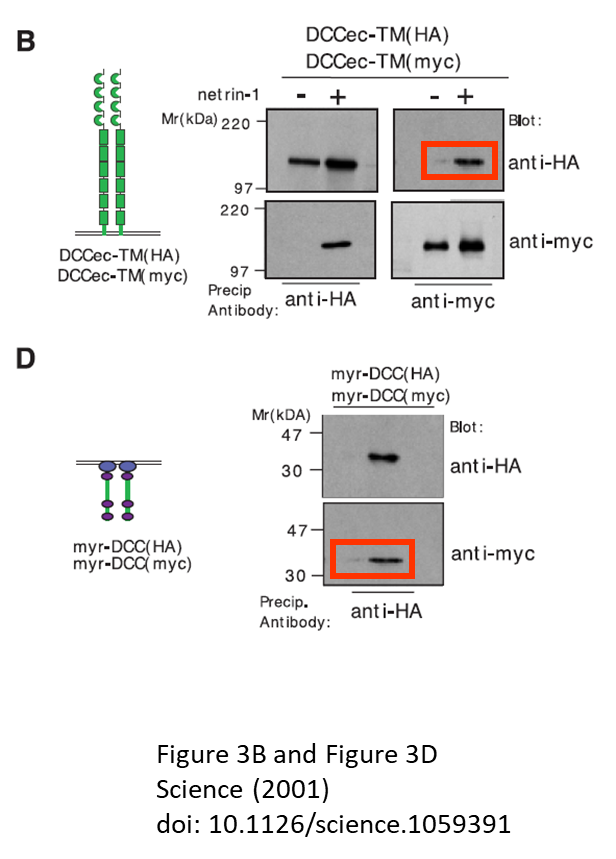
Regarding a fraudulent Science paper with just two authors, the other one being Tessier-Lavigne’s cheating protege Elke Stein, Stanford, when pushed, now declared that it was the journal or the publisher who faked the data:
“The University wrote that “The origin of the tiling and of the partial overlaps is unknown but may have occurred during transfer of images to the journal.””
Stanford’s problem is that somehow the media suddenly found an interest in their President’s fraud, and this time the elite university failed to suppress this interest. On 29 November 2022, the elite university announced to start an investigation, because what else can they answer to all these nosy journalists calling-in after Stanford Daily‘s dam-breaking reporting.
But why all this kerfuffle now? It seems, Cheshire caused it by writing to Stanford University Ethics and Compliance Helpline and to Stanford Daily (among other addressees) on 4 October 2022. The former acknowledged receipt, and the latter published the above bombshell article. And now US media is over it, all crying scoop.
By the way, look at this classic by Stanford’s President and his dear protege Elke S, with new findings by Elisabeth Bik:
Kyonsoo Hong , Lindsay Hinck , Makoto Nishiyama , Mu-ming Poo , Marc Tessier-Lavigne , Elke Stein A Ligand-Gated Association between Cytoplasmic Domains of UNC5 and DCC Family Receptors Converts Netrin-Induced Growth Cone Attraction to Repulsion Cell (1999) doi: 10.1016/s0092-8674(00)80804-1
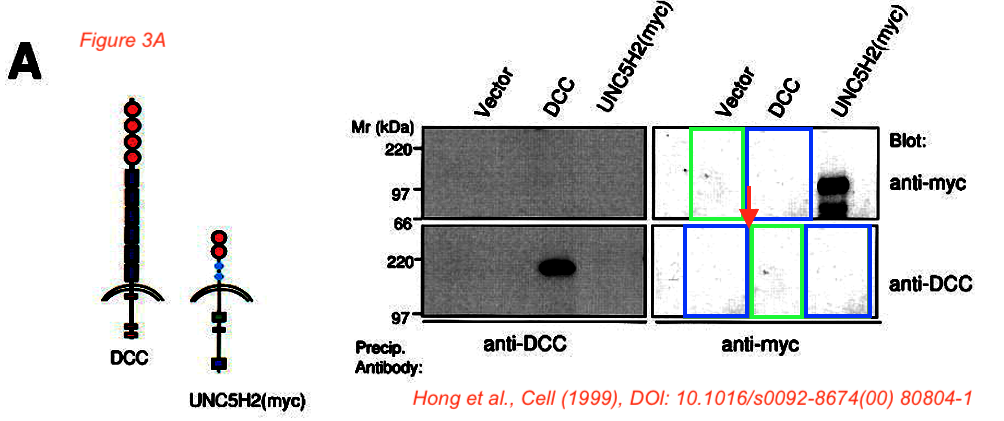
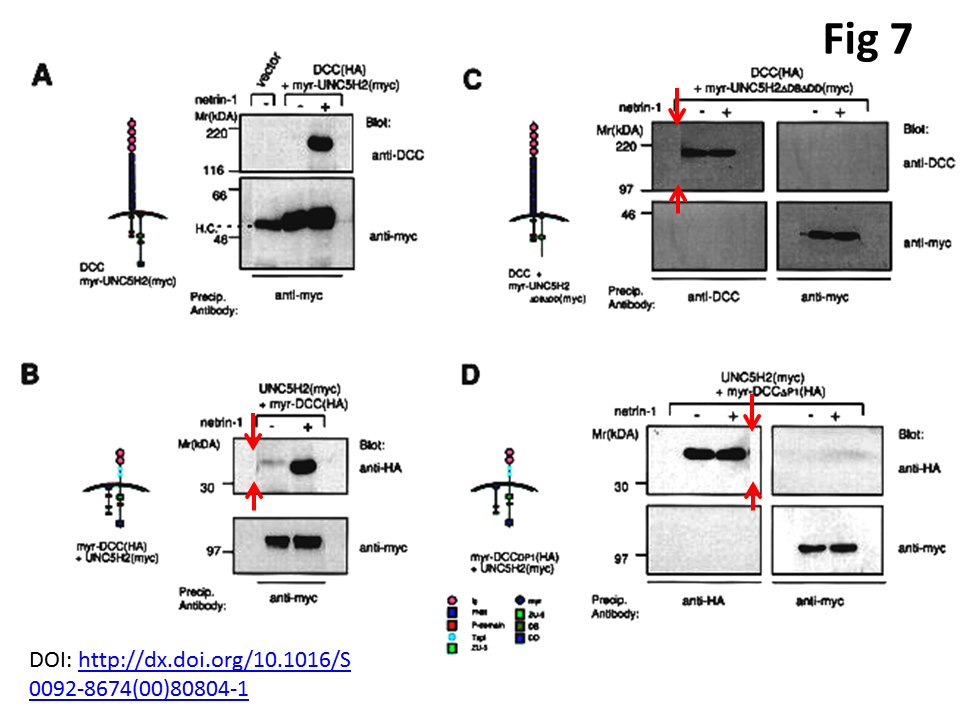
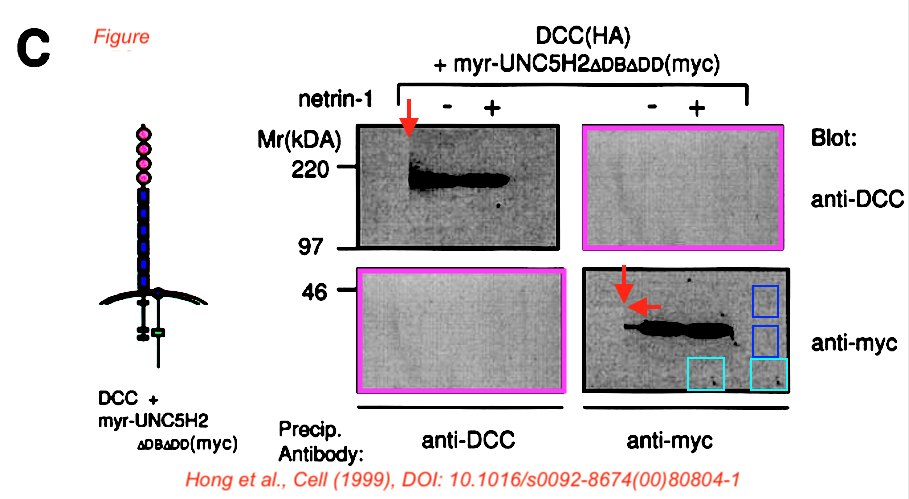
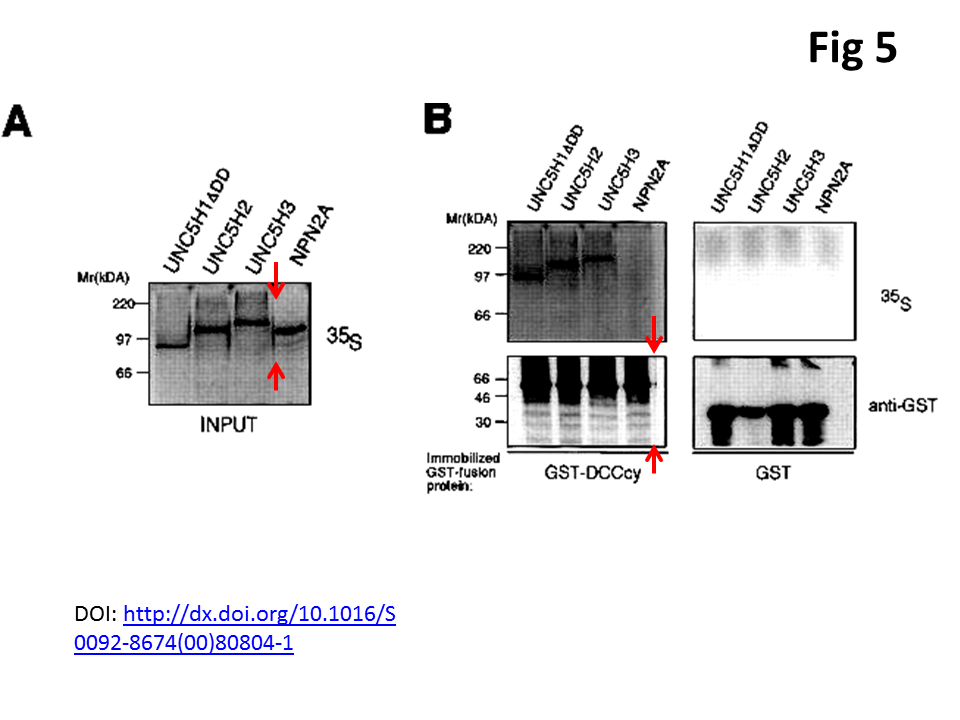
Stein used to be associate professor at Yale, but it looks like she left around 10 years ago. She founded several businesses, like “Scientific Advising and Consulting” (est 2013, “Set up a research lab in Molecular Oncology at Stanford University“, “Felicitas-Gaia Foundation” (est 2008, “Bioethic and Outreach as well as Science Awareness“), and “Scientists against peer sabotage”, est 1990 and described on LinkedIn as:
“Scientist against peer sabotage and corruptive activities in biomedical research. The goal is to preserve research material, data and respect research accomplishments of Scientists (and their privacy) that are/ were funded by federal and private foundations or special donations.”
Eventually she returned to Tessier-Lavigne and is recorded as “visiting faculty scholar” in Stanford, where she declares to have “Identified a Biomaker for Infantile Autism” and that “non-fat/ low-fat milk is good for you!“. She is also writing a book “How to make your child autistic” (“What parents and the Society need to do to prevent that their children become autistic.”) Her other research topics at Stanford are “Why is it bad to work in retail when being educated, white, single and female“, and
“Investigation of the causes that triggered the traumatic increase in autism spectrum disorders especially since implementation of ACA. Protecting the future of the next generation of Dickenson, Einstein, Michelangelo and Tesla.”


Stein may look unhinged and paranoid on top of being a research cheater to you, but the Stanford president Tessier-Lavigne has been protecting her for decades. I will let expert journalists figure out why 😉
Meanwhile, the affair is reaching bigger and bigger media. In the Wall Street Journal, Science Editor-in-Chief Holden Thorp was quoted defending the Stanford couple’s fraud as “honest mistakes”, while admitting to act as a dishonest opportunistic sycophant without any ethics principles:
“Science editor in chief Holden Thorp said in an interview Thursday that the errors in those studies weren’t uncommon in papers from that period, sometimes the result of honest mistakes and sometimes intentional efforts to make images look better. He said the standard for publishing images has changed over the past two decades.
Dr. Thorp said he has been speaking with Dr. Tessier-Lavigne in recent days and while authors are often defensive when their work is questioned, the Stanford president has been “completely collaborative with us.”
He said Science hasn’t yet determined its next steps, which could include publishing the previously written errata, updating them, or retracting papers if additional concerns come to light.”
What Thorp really squeeked: no retractions in Science unless Stanford or NIH order them.
Public apologies
Gary Dunbar is professor of psychology once affiliated with the Central Michigan University (CMU) in USA, where he used to be director of the Field Neurosciences Institute Laboratory (FNI), which seems to have changed owner but retained Dunbar. In 2020, CMU described Dunbar’s research on the occasion of his receiving a Gusi Peace Prize for his “contributions toward peace and respect for human life and dignity“:
“His recent research focuses on using stem cells, dietary supplements and pharmacological treatments for cognitive or motor deficits following brain damage, spinal cord injury, glioblastoma and neurodegenerative diseases, such as Huntington’s, Parkinson’s and Alzheimer’s diseases.”
Yes, I know, it’s funny already, but now you have to see the pictures for which Dunbar now makes his lab members to publicly apologise for. This was flagged by Cheshire in October 2021, an MDPI study suggesting to treat Alzheimer’s with borate:
Panchanan Maiti, Jayeeta Manna, Zoe N. Burch , Denise B. Flaherty, Joseph D. Larkin, Gary L. Dunbar Ameliorative Properties of Boronic Compounds in In Vitro and In Vivo Models of Alzheimer’s Disease International Journal of Molecular Sciences (2020) doi: 10.3390/ijms21186664
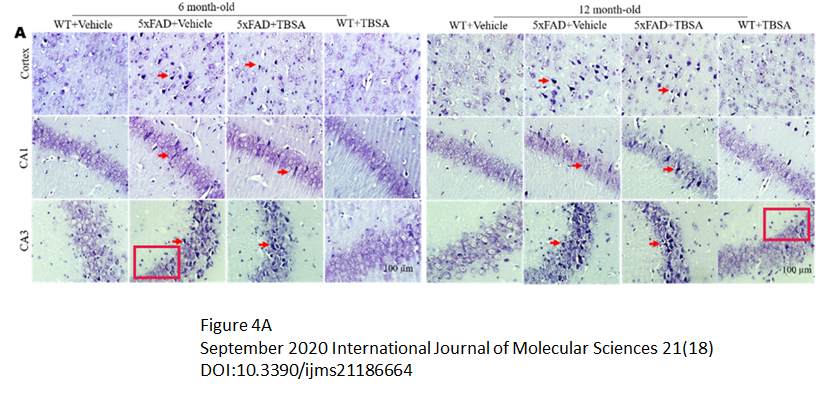

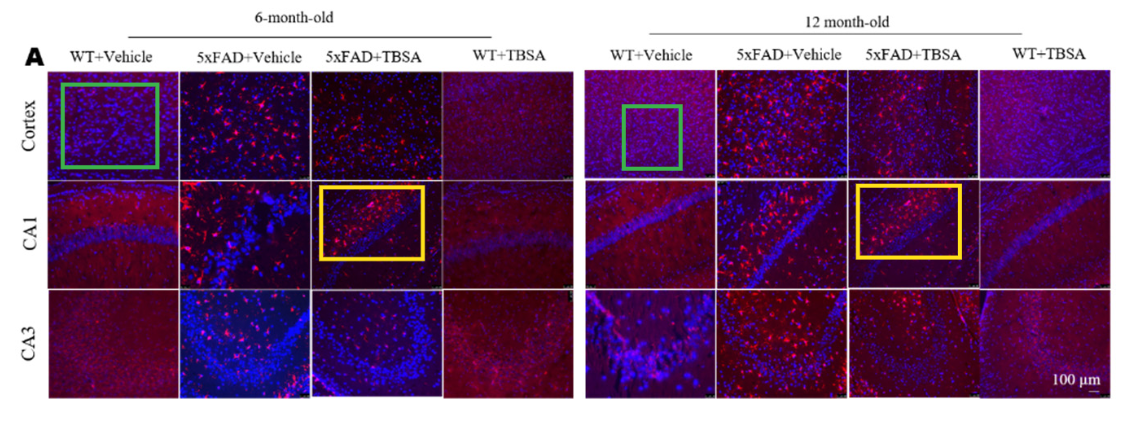
Dunbar swiftly replied:
“While selecting the representative images for publication, the first author inserted some of the images twice (see explanation and details in his message pasted below). These mistakes did not affect the analyses or scientific conclusions of this research. However, we have contacted the journal editors and have asked to have the corrected versions of these figures published as a corrigendum.“
Attached were replacement images and an apology by Panchanan Maiti, adjunct faculty member at an institute in Hyderabad, at Dunbar’s Central Michigan University, and at the Saginaw Valley State University; he is also research scientist at the “faith-based healthcare organization” Ascension St. Mary’s, also in Saginaw, Michigan. Keep that institution in mind please.
“I would like to sincerely apologize for my mistakes of inserting the wrong images […] All these errors were entirely mine and none of the co-authors were involved in these mistakes.“
But Cheshire felt that Dr Maiti and Dunbar might want to have another look because “the aspect ratio differs on some of the overlapping images” and because there were even more duplications in Fig 4A:
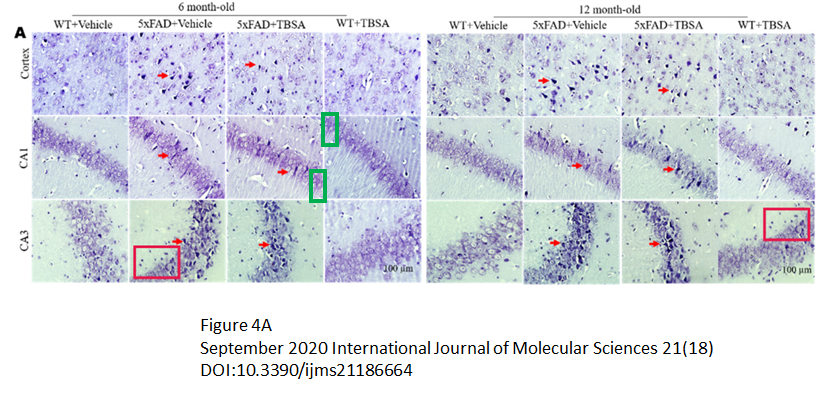
Dunbar replied announcing “a careful investigation of this, along with a thorough review of all the data in this study“. The Cheshire wondered in March 2022: “Could the authors comment on the apparent reuse of control tissue across two papers?“

Dunbar replied to the new finding in July 2022:
“As indicated in an earlier reply, the lead author on the paper apologized for these mistakes, and because there were variations in the color of the duplicated images, we have, as you wisely suggested, conducted a complete re-analyses of the data, including re-doing the cell counts and analyses, as well as correcting or re-doing the figures in question. These have been submitted for the journal to review. […] Again, we sincerely apologize for these mistakes, but are confident (particularly after re-doing the analyses) that the errors were restricted to the selection of the images and that the underlying findings and conclusions are accurate.“
In August 2022 a PubPeer commenter suggest that the numbers in a figure on mouse memory tests were made up. In November 2022, Dunbar found a creative excuse why the numbers made no sense. He also informed Cheshire that he is “contacting the journal to see if more extensive corrections can be made or not.”
This was the other paper Cheshire mentioned above, sponsored by Ascension St. Mary’s and published by Springer Nature’s BioMedCentral. It suggested to cure Alzheimer’s with curcumin (donated by Verdure Sciences, Noblesville, IN), because curcumin is magic and cures every disease, right:
Panchanan Maiti, Zackary Bowers , Ali Bourcier-Schultz , Jarod Morse, Gary L. Dunbar Preservation of dendritic spine morphology and postsynaptic signaling markers after treatment with solid lipid curcumin particles in the 5xFAD mouse model of Alzheimer’s amyloidosis Alzheimer s Research & Therapy (2021) doi: 10.1186/s13195-021-00769-9
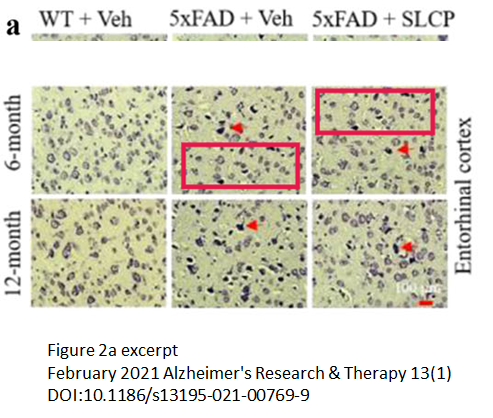


Also there, Dunbar replied in October 2021 on PubPeer:
“Thanks for bringing this to our attention. We have initiated an investigation into what happened here and this will include a re-examination of all the data in this study. Based on this, we will inform the journal editor and request the appropriate actions be taken to rectify these errors.“
A correction was issued by BioMedCentral in March 2022. The correction was incorrect, as Cheshire noticed:

Dunbar protested that he and his team did their best to correct that paper and added:
“We sincerely apologize for these mistakes and can assure you that we have taken rigorous measures to prevent such mistakes in the future.“
Cheshire found more In August 2022, but Dunbar moved on since:
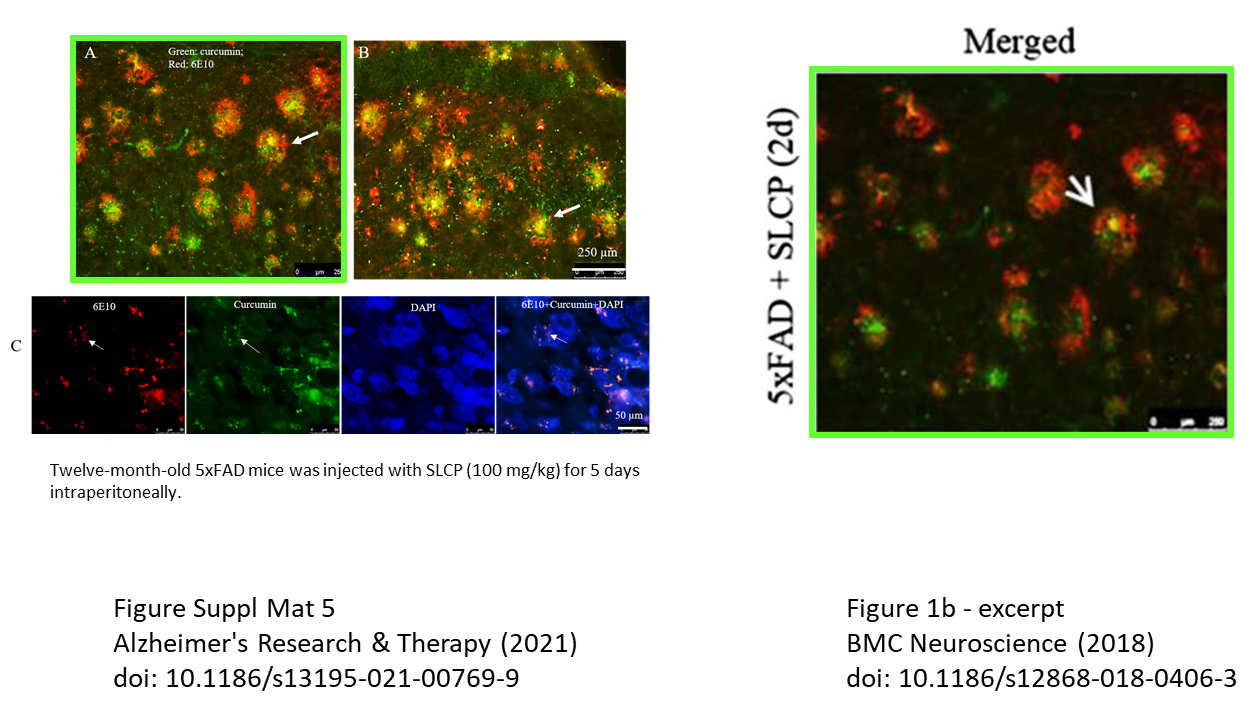
For the latter curcumin paper by Ascension St Mary paper, Dunbar announced in October 2021 to have “initiated an investigation into what happened here” and to “inform the journal editor and request the appropriate actions be taken to rectify these errors.” Obviously he moved on since, there was not even a correction.
Panchanan Maiti , Leela Paladugu , Gary L. Dunbar Solid lipid curcumin particles provide greater anti-amyloid, anti-inflammatory and neuroprotective effects than curcumin in the 5xFAD mouse model of Alzheimer’s disease BMC Neuroscience (2018) doi: 10.1186/s12868-018-0406-3
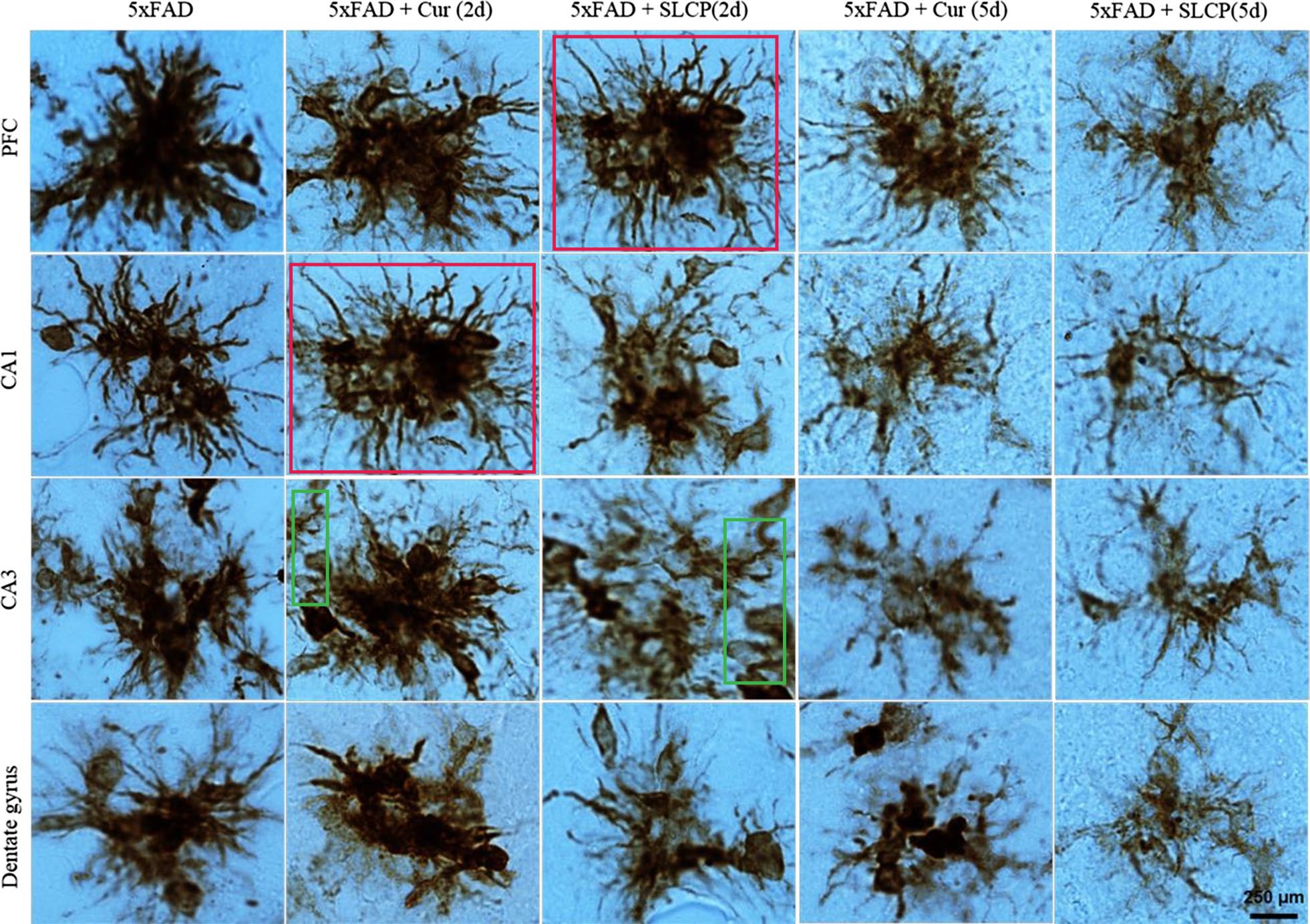
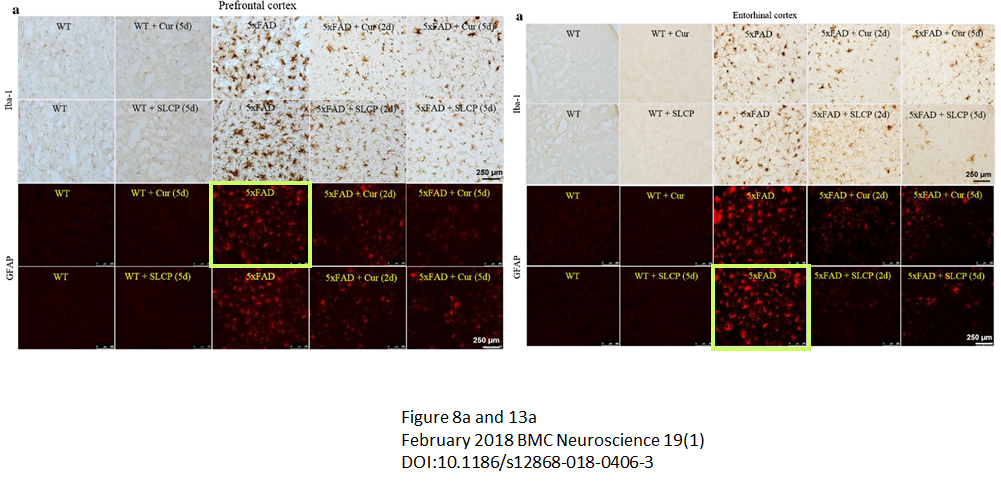
Here more groundbreaking Alzheimer’s research with curcumin from Dunbar’s lab, no conclusions ever affected. In MDPI, sponsored by Ascension St. Mary’s Hospital, curcumin product provided by Arjuna Natural Pvt. Ltd. India:
Jayeeta Manna, Gary L. Dunbar , Panchanan Maiti Curcugreen Treatment Prevented Splenomegaly and Other Peripheral Organ Abnormalities in 3xTg and 5xFAD Mouse Models of Alzheimer’s Disease Antioxidants (2021) doi: 10.3390/antiox10060899
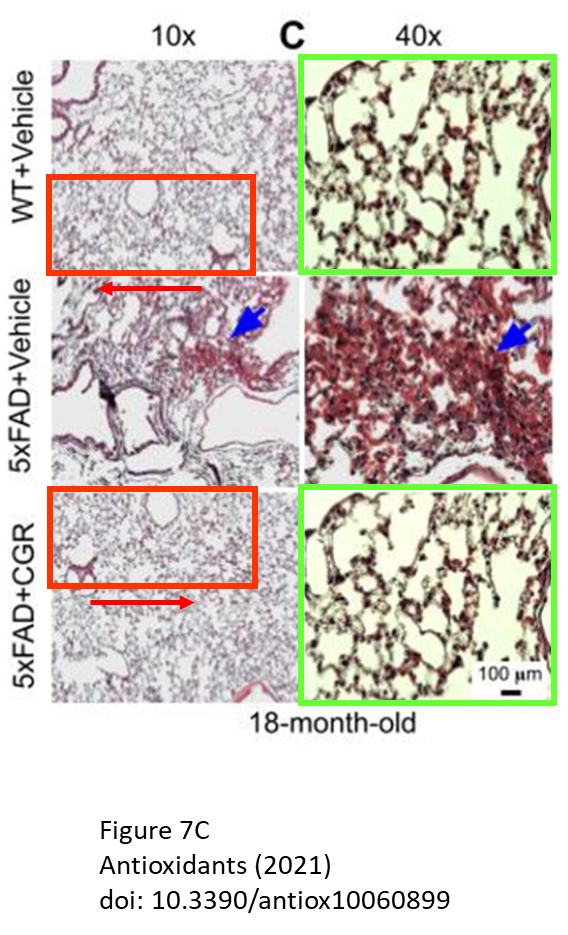
How about nanocurcumin, also by Verdure Science (Noblesville, IN)? It was done in collaboration with CMU professor Julien Rossignol, who together with Dunbar used to lead FNI as co-directors:
Panchanan Maiti, Tia C. Hall , Leela Paladugu , Nivya Kolli , Cameron Learman , Julien Rossignol , Gary L. Dunbar A comparative study of dietary curcumin, nanocurcumin, and other classical amyloid-binding dyes for labeling and imaging of amyloid plaques in brain tissue of 5×-familial Alzheimer’s disease mice Histochemistry and Cell Biology (2016) doi: 10.1007/s00418-016-1464-1
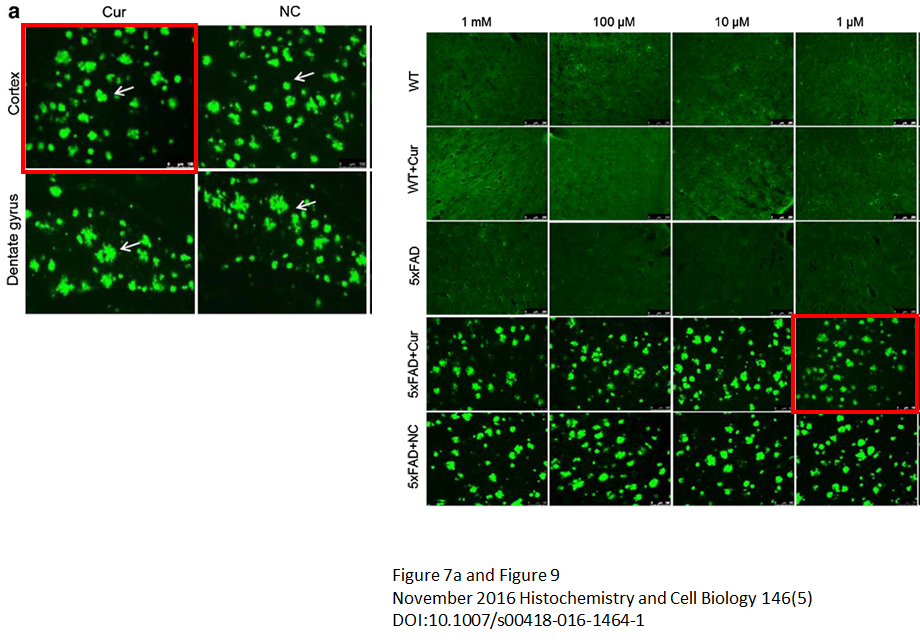
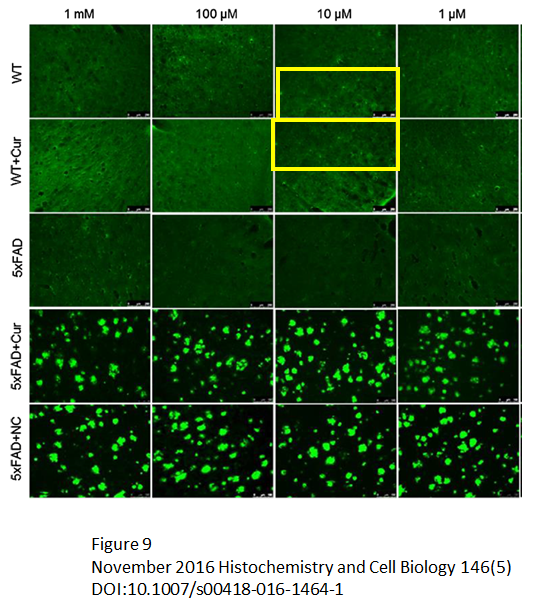
Dunbar promised in October 2021: “We are now investigating what happened and are re-analyzing the data in this study and will be notifying the journal editor to take appropriate actions.” Obviously he had better things to do.
There is more fake science from Dunbar’s lab on PubPeer (a dozen of papers in total), and it most seems to have Maiti as co-author. But! Look at this stem cell study to cure brain trauma:
S. T. Peruzzaro , M. M. M. Andrews , A. Al-Gharaibeh, O. Pupiec , M. Resk, D. Story , P. Maiti, J. Rossignol , G. L. Dunbar Transplantation of mesenchymal stem cells genetically engineered to overexpress interleukin-10 promotes alternative inflammatory response in rat model of traumatic brain injury Journal of Neuroinflammation (2019) doi: 10.1186/s12974-018-1383-2
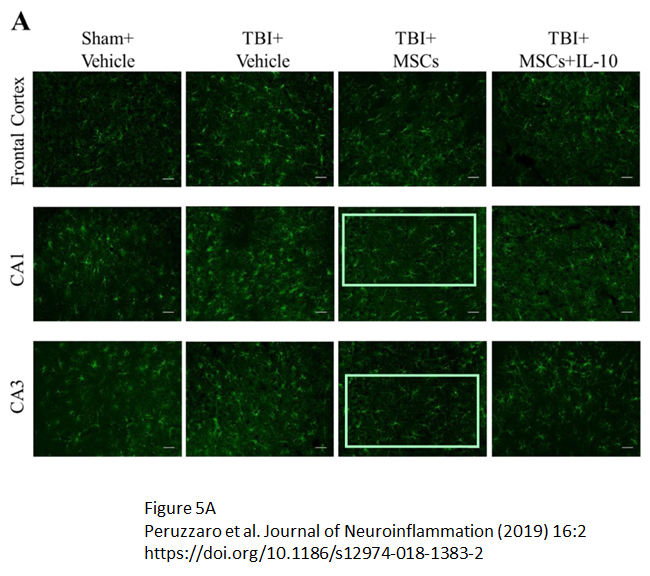
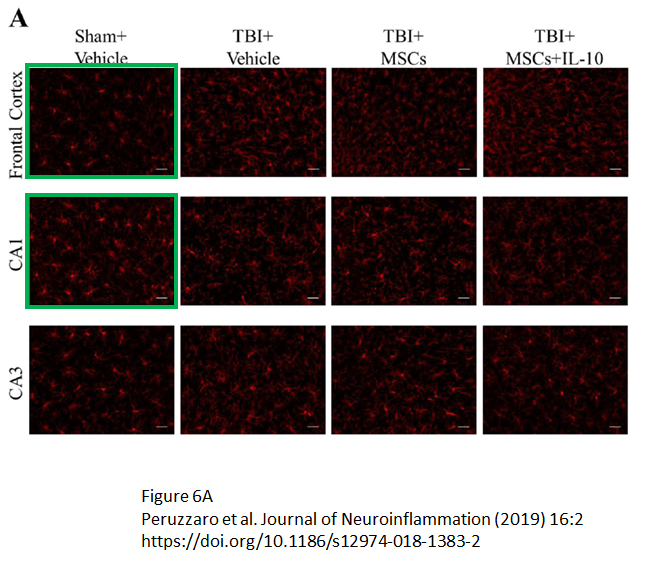
Dunbar replied in October 2021:
“While selecting the representative images for publication, the first author inserted some of the images twice (see explanation in message pasted below). These mistakes did not affect the analyses or scientific conclusions of this research. However, we have contacted the journal editors and requested that a corrigendum be issued with the corrected images.“
The ensuing BMC correction of January 2022 mentioned:
“The mistake occurred due to a copying and labeling error with image selection; all analyses remain the same.”
But Maiti was not first author here. The first author apologised on PubPeer:
“I deeply apologize for this mistake. The mistake occurred due to a copying and labeling error. I would greatly appreciate the opportunity to rectify this mistake. This was solely my mistake and not that of any of my colleagues on the paper.
Sincerely, Sarah Peruzzaro“
Also for the following MDPI paper about sour cherries (!) curing Alzheimer’s, Dunbar forced the first author to publicly apologise:
Zackary Bowers , Panchanan Maiti , Ali Bourcier, Jarod Morse, Kenneth Jenrow , Julien Rossignol , Gary L. Dunbar Tart Cherry Extract and Omega Fatty Acids Reduce Behavioral Deficits, Gliosis, and Amyloid-Beta Deposition in the 5xFAD Mouse Model of Alzheimer’s Disease Brain Sciences (2021) doi: 10.3390/brainsci11111423
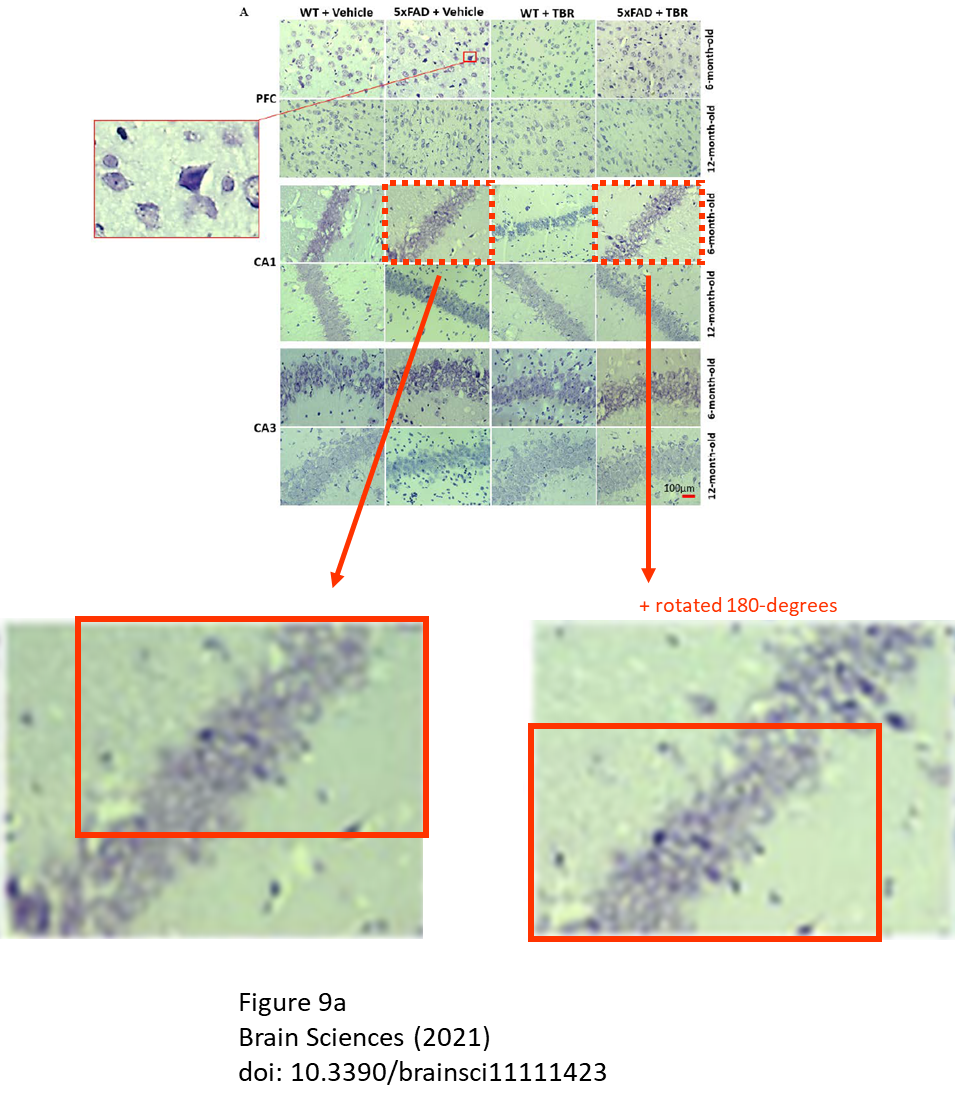
Zackary Bowers took the full blame in August 2022:
“I sincerely apologize and would like to emphasize that by no means was I attempting to mislead or misrepresent the experiment. This was a copy-and-paste error. I did invert the image to keep the orientation consistent with the other images.”
In yet another MDPI paper, about a diabetes drug repurposed to cure Alzheimer’s, it was the first author Leela Paladugu who was forced to publicly apologise:
Leela Paladugu , Abeer Gharaibeh , Nivya Kolli , Cameron Learman , Tia C. Hall, Lixin Li , Julien Rossignol , Panchanan Maiti, Gary L. Dunbar Liraglutide Has Anti-Inflammatory and Anti-Amyloid Properties in Streptozotocin-Induced and 5xFAD Mouse Models of Alzheimer’s Disease International Journal of Molecular Sciences (2021) doi: 10.3390/ijms22020860
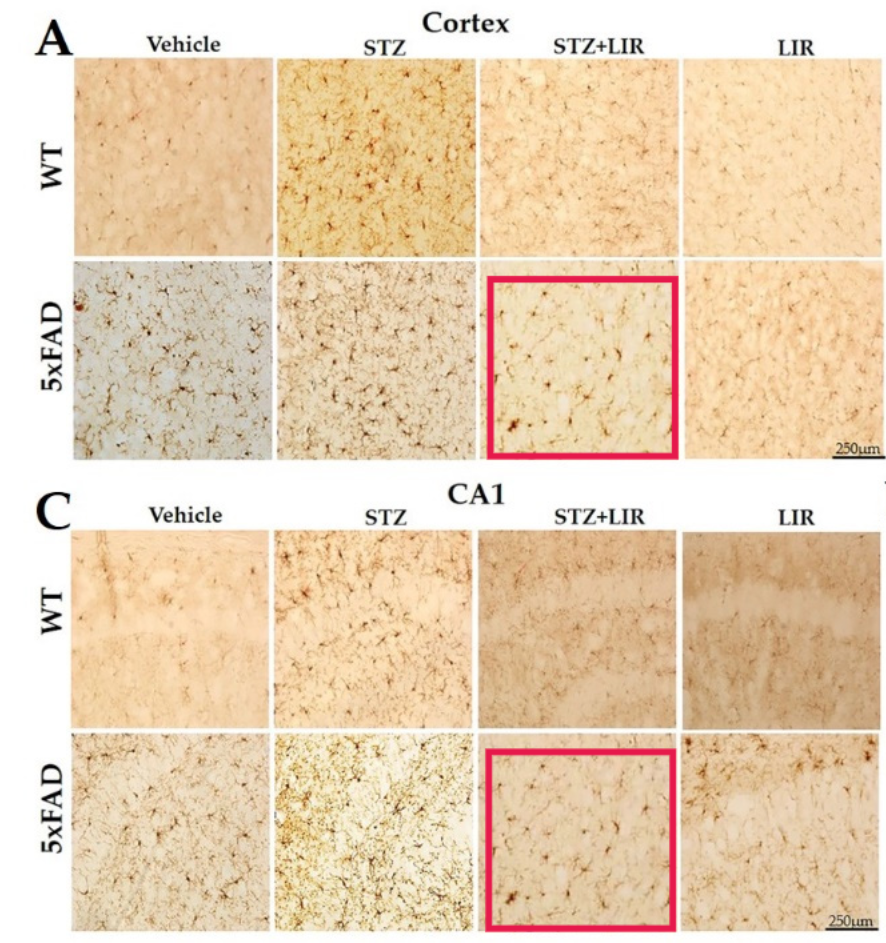
Dunbar announced in October 2021 a corrigendum (which was obviously cancelled), and attached a “public apology” by the first author:
“During the process of adjusting the brightness and contrast of the representative images for better quality, the color might have changed which was an unforeseen mistake from my end. This did not alter the data analyses of the study. I sincerely apologize for the mistake and consider this as a learning opportunity to be extra vigilant in future. Many thanks, Leela“
If I wildly speculate here that it was Dunbar who orders his lab members to introduce these “mistakes” in order to a) create the desired research results for his quack cures, and b) avoid getting a sack and lose US visa, and now he bullies them to publicly grovel and apologise for unaffected conclusions to save his own arse…
Maybe it’s relevant that Dunbar is also listed as editorial board member with the predatory publisher PeerTechz from Hyderabad.
And it seems, CMU may have had enough of his antics. Dunbar and his FNI were moved? sold? trashed? Its new owner are the faith quacks at Ascension St Mary, Dunbar’s new employer since at least 2019. Dunbar didn’t reply to my email inquiry, also CMU remained silent.
Even astronauts
Gizmodo reports:
“The Japan Aerospace Exploration Agency (JAXA) says a team of researchers fabricated the results of an experiment, led by one of its astronauts, that sought to simulate daily life on board the International Space Station (ISS).
JAXA stated that it would subject astronaut Satoshi Furukawa to disciplinary action over data tampering, Japanese media reported. The experiment in question, conducted between 2016 and 2017, involved 40 participants who were confined to closed environments to simulate what astronauts experience during spaceflight.
The participants spent about two weeks at a facility in Tsukuba, a city northeast of Tokyo, after which time their stress levels and mental well-being were to be assessed by the overseeing researchers. Or at least, that was the plan. Instead, the two researchers responsible for conducting the interviews fabricated the data, compiling psychological assessments without actually having done the interviews and rewriting the diagnosis of the participants, according to NHK World-Japan.”
At least in Japan, one has to take responsibility for the fraud your team members commit.
“JAXA began investigating the results of the research in November 2020 upon noticing that something wasn’t quite right with the data, and subsequently suspending the 190 million yen ($1.4 million) experiment. The researchers involved claimed that they were too busy to dedicate enough time towards the data gathering for the experiment, according to to JAXA vice president Hiroshi Sasaki and as reported in Kyoto News.
The Japanese space agency will reprimand 58-year-old astronaut Furukawa, who was overseeing the experiment as project supervisor. However, since Furukawa was not personally involved in fabricating the data, his upcoming mission to the ISS in 2023 will not be affected.”
$1.4 million sounds a lot, but in USA Marc Tessier-Lavigne and Elke Stein embezzled much more with their fake science, and there will be exactly zero consequences once Stanford gets the media under control again.
Scholarly Publishing
Real papermill heroes
Science, or rather The BMJ, has spoken. A peer-reviewed paper in the elite medical journal decreed who does all this work uncovering papermill, and it’s most certainly not Smut Clyde and other irrelevant non-persons.
It’s Retraction Watch.
Cristina Candal-Pedreira , Joseph S Ross , Alberto Ruano-Ravina , David S Egilman , Esteve Fernández , Mónica Pérez-Ríos Retracted papers originating from paper mills: cross sectional study BMJ (2022) doi: 10.1136/bmj-2022-071517
The Spanish authors (mostly from University of Santiago de Compostela) discovered that
a) there are papermills and they are almost all Chinese (wrong on the latter),
b) many papermill products get retracted, all thanks to editorial investigations (lol, rofl), and
c) all papermill retractions are registered as such in the Retraction Watch database.
As Alexander Magazinov criticised on PubPeer, if the retraction notice does not mention papermills and the omniscient Retraction Watch experts won’t log those retractions as due to papermilling, then it won’t enter the analysis of our esteemed experts from Spain. Thus, if it’s not on Retraction Watch, it didn’t happen.
The authors mentioned in passing:
“Retraction Watch also uses PubPeer and the list of probable paper mill papers published by Elisabeth Bik and other investigators.11“
Apparently all the threads on PubPeer reported papermill fraud were posted by Retraction Watch Watchdogs, who knew. Also, the original papermill investigation, unreferenced, was this:
The full-service paper mill and its Chinese customers
An investigation by Elisabeth Bik, Smut Clyde, Morty and Tiger BB8 reveals the workings of a paper mill. Its customers are Chinese doctors desperate for promotion. Apparently even journal editors are part of the scam, publishing fraudulent made-up science.
Many more papermill investigations, mostly by Smut Clyde, but also by Magazinov and others, followed since that first report from February 2020. Still, our Spanish experts saw no need to even mention irrelevant and incompetent sources, like proposed by Hoya camphorifolia on PubPeer:
“FWIW, a collection of papermill spreadsheets is available here.“
The Chinese Paper Mill Industry: Interview with Smut Clyde and Tiger BB8
Unlike those fake paper mill products, this interview failed editorial review and journal quality control.
By the way, the BMJ article contains this in the introduction:
“In addition to selling the authorship of scientific papers, these organisations offer other services, ranging from making available or fabricating a database on which a study can be based, to falsifying a journal peer review so as to enable a paper to be published more easily.5“
The reference 5 is to a “paper” by the stalking troll Jaime Teixeira da Silva (JATdS), who publishes almost exclusively in predatory journals:
Teixeira da Silva JA Paper mills and on-demand publishing: risks to the integrity of journal indexing and metrics. Med J Armed Forces India (2021) https://doi.org/10.1016/j.mjafi.2020.08.003
I keep suggesting to cite more JATdS masterpieces, like this, this or this, or even better:

That recent papermill rant by JATdS is apparently a must-cite for every Real Papermill Hero out there, which kind of proves how competent they all are:
Editors and other real papermill heroes
“Long story short, we investigated our published papers and then retracted those with data integrity issues. That is it.” – Dr Heather Smith, Editor-in-Chief
For all I know, the BMJ article may have been peer-reviewed by JATdS and Ivan Oransky of Retraction Watch.
Sanjeev’s innocence
PLOS One are by now known as probably the only journal which more or less consequently acts on research fraud. But what about other journals of the PLOS family, the high-ranking ones with fancier editorial boards?
I have no good news here. Look what PLOS Biology just did:
Dimple Notani , Kamalvishnu P. Gottimukkala , Ranveer S. Jayani , Amita S. Limaye , Madhujit V. Damle , Sameet Mehta , Prabhat Kumar Purbey , Jomon Joseph , Sanjeev Galande Global regulator SATB1 recruits beta-catenin and regulates T(H)2 differentiation in Wnt-dependent manner PLoS Biology (2010) doi: 10.1371/journal.pbio.1000296
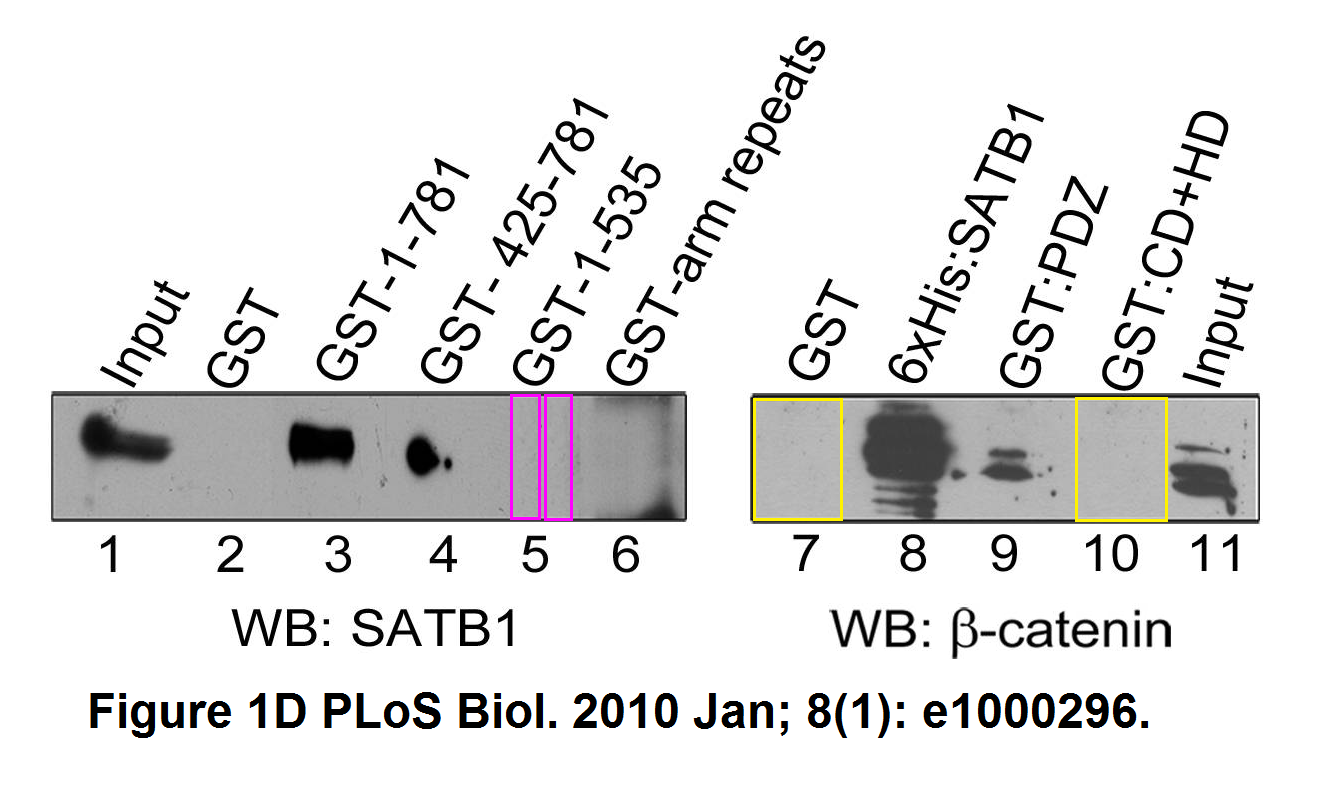
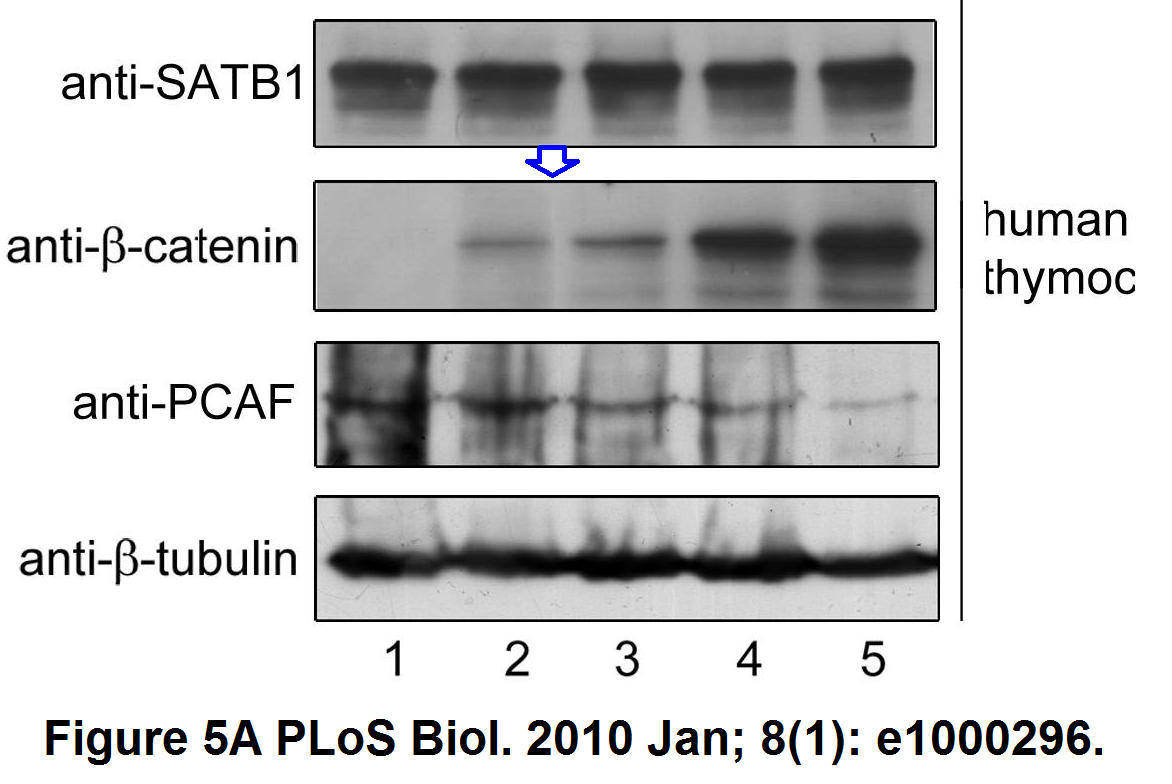
The totally fraudulent Figure 1D was flagged in November 2019. Right away, Sanjeev Galande, Professor at the Indian Institute of Science Education and Research (IISER-Pune) and since 2021 Dean of the School of Natural Sciences at Shiv Nadar University in Delhi, commented on PubPeer:
“This data is generated more than ten years ago while I was working at another institution. I will have to dig into the records and pull out the original blot. Will revert when I find the same.”
Before I tell you how PLOS Biology resolved the case, you should know that Galande has a longer PubPeer record, including a retraction with the sacked cheater Oliver Bischof:
Academic throne succession: from Anne Dejean to Oliver Bischof
Anne Dejean is a very important cancer researcher in France. To whom shall she bequeath her high-achieving Institut Pasteur lab when she retires? The German shooting star Oliver Bischof is the right man to continue Dejean’s craft.
Here some more Galande science, also flagged in November 2019:
P. Pavan Kumar , Prabhat Kumar Purbey , Chandan Kumar Sinha , Dimple Notani , Amita Limaye , Ranveer S. Jayani , Sanjeev Galande Phosphorylation of SATB1, a global gene regulator, acts as a molecular switch regulating its transcriptional activity in vivo Molecular Cell (2006) -doi: 10.1016/j.molcel.2006.03.010
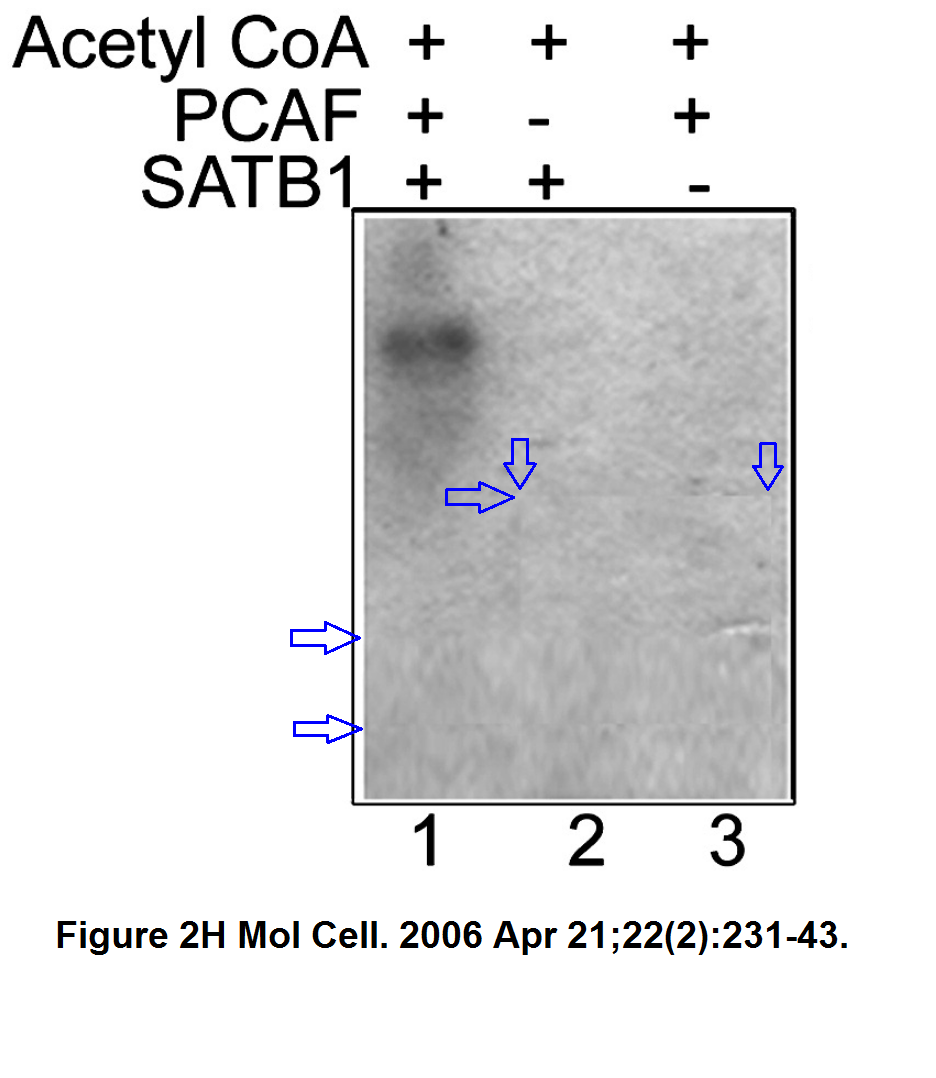
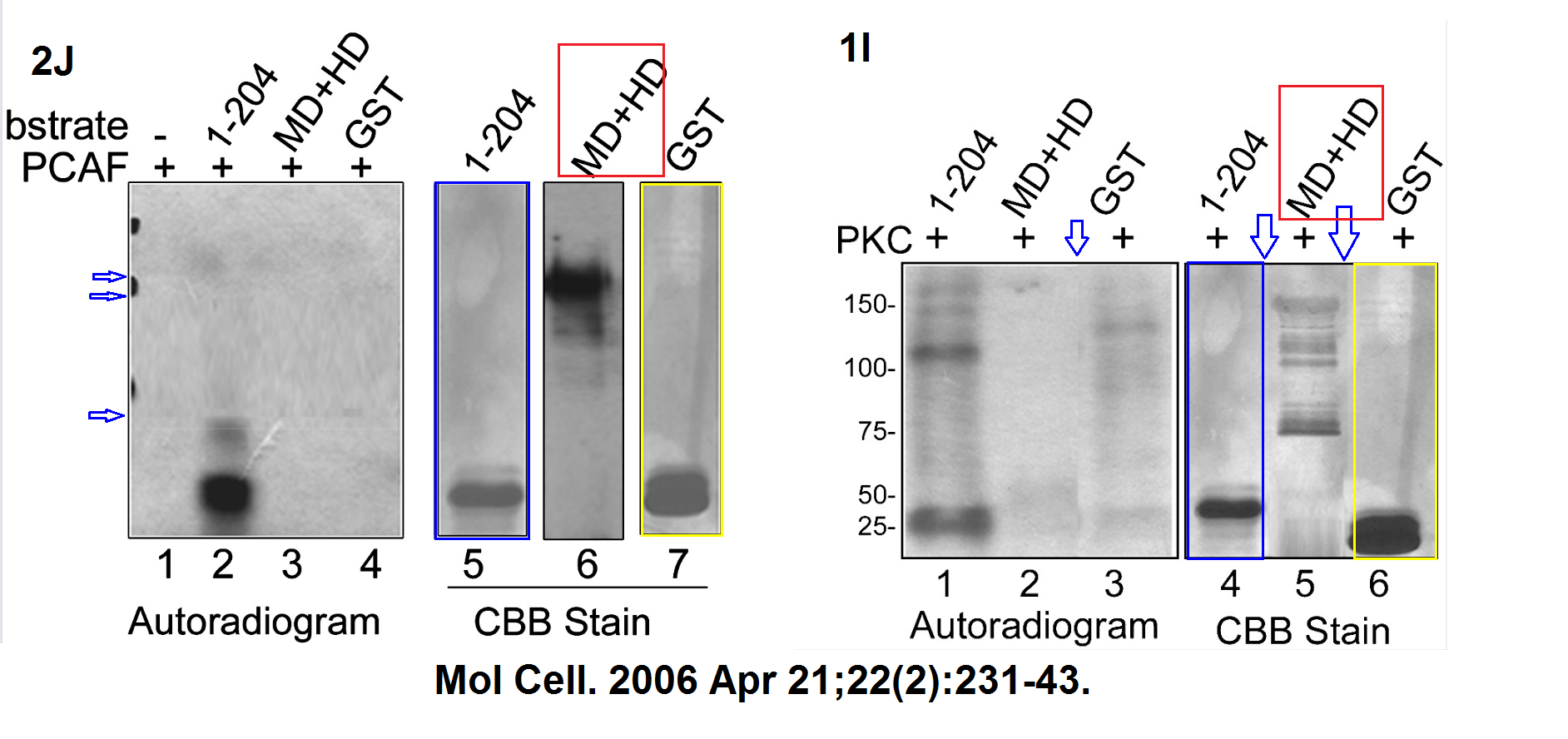
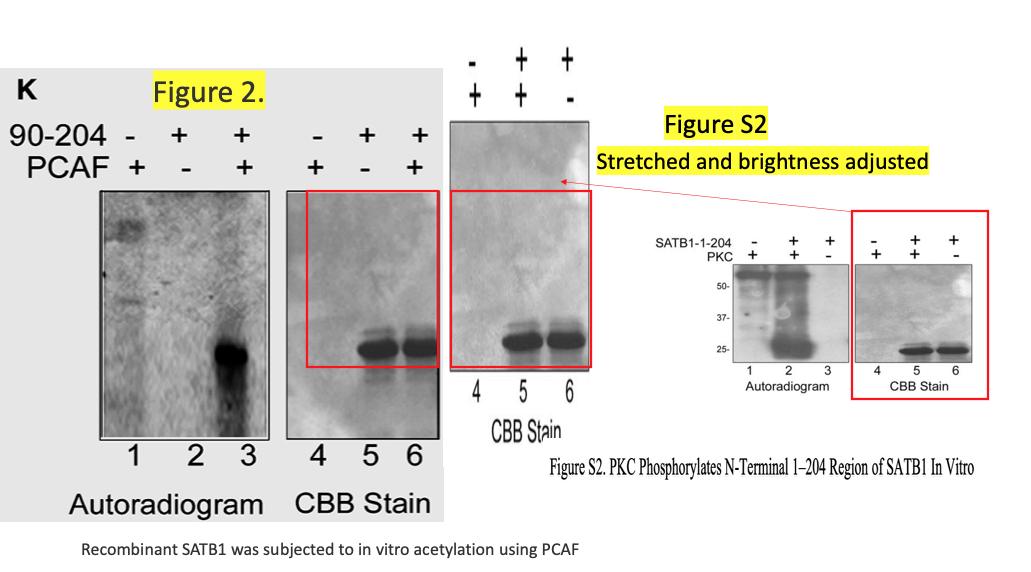
The gel in Figure 2H looks very fraudulent, what with the boxed background features likely used to remove undesired signal. The other problems don’t look like innocent mistakes either. This also is fake, by similar author collective:
Pavan P. Kumar , Sameet Mehta , Prabhat Kumar Purbey , Dimple Notani, Ranveer S. Jayani , Hemant J. Purohit , Dhananjay V. Raje , Dyavar S. Ravi , Ramesh R. Bhonde , Debashis Mitra , Sanjeev Galande SATB1-Binding Sequences and Alu -Like Motifs Define a Unique Chromatin Context in the Vicinity of Human Immunodeficiency Virus Type 1 Integration Sites Journal of Virology (2007) doi: 10.1128/jvi.01405-06
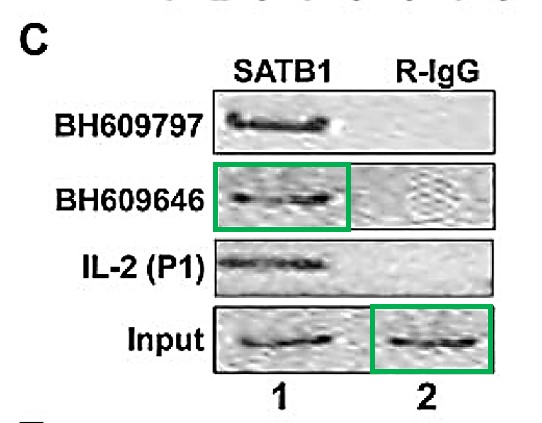
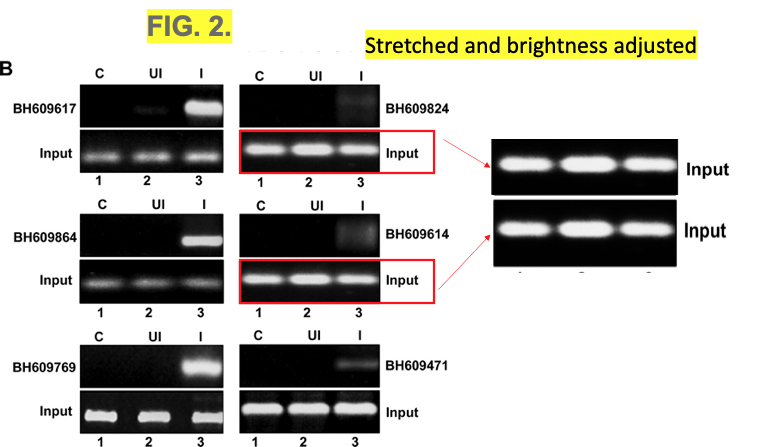
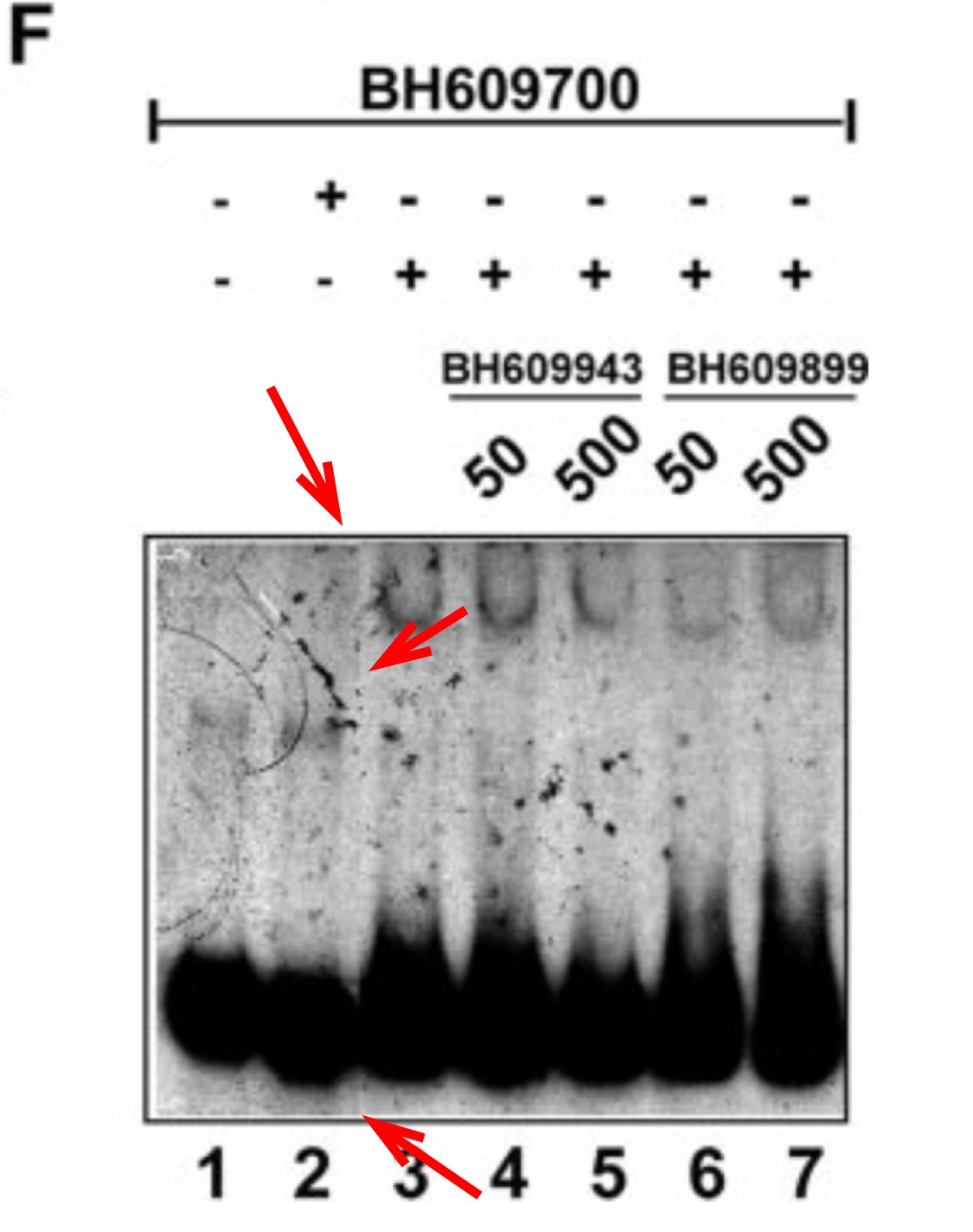
Rogue students? Here is something from Galande’s past as postdoc:
Sanjeev Galande , Terumi Kohwi-Shigematsu Poly(ADP-ribose) polymerase and Ku autoantigen form a complex and synergistically bind to matrix attachment sequences Journal of Biological Chemistry (1999) doi: 10.1074/jbc.274.29.20521
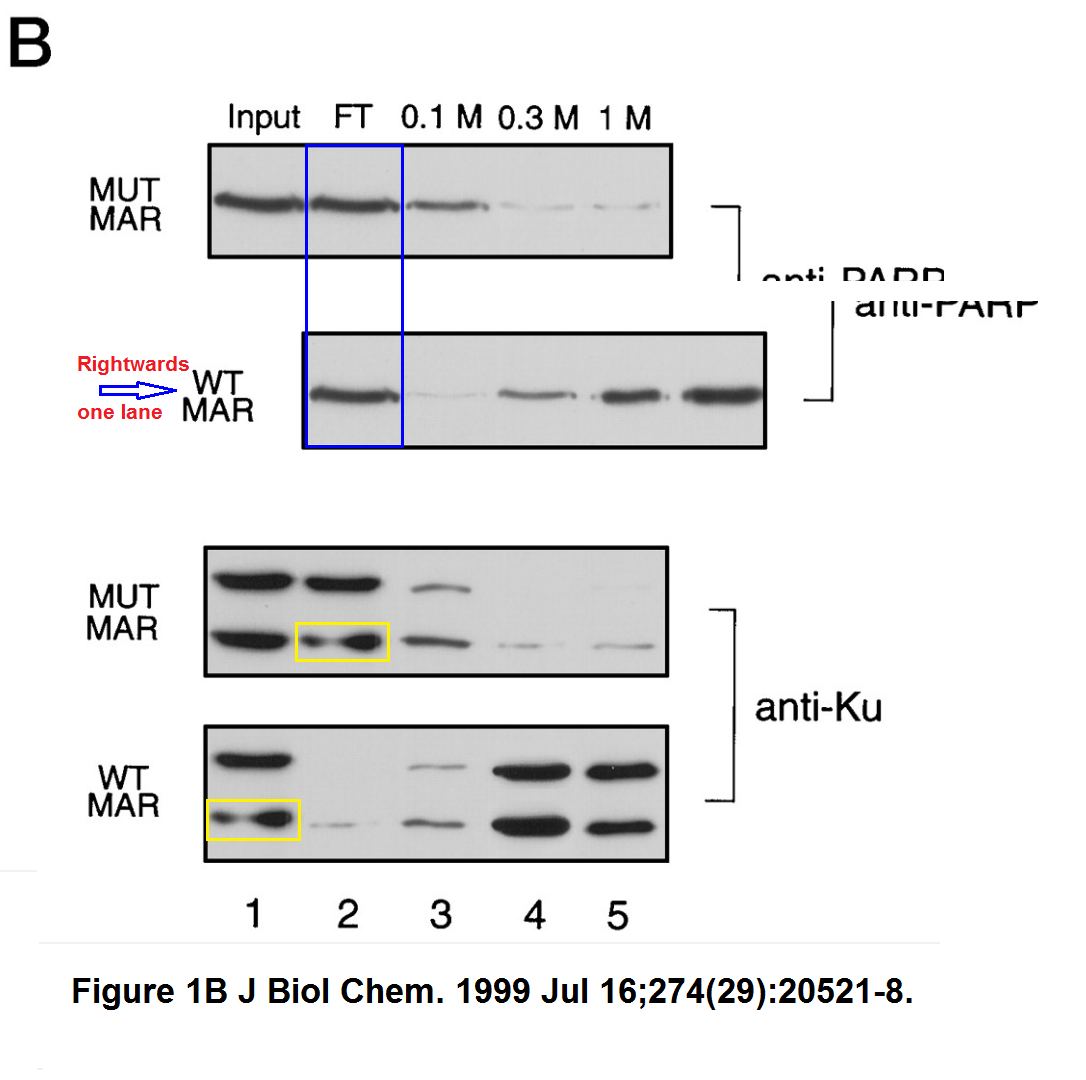
Again, there is more on PubPeer. PLOS Biology editors knew about these problems, and here an excerpt from the Expression of Concern the journal issued on 23 November 2022:
“The corresponding author provided the original underlying images and quantitative data to support several figures in the article (S1 File), but stated that the original data are no longer available for the western blots in Fig 1B and 1D left panel, Figure 4B bottom panel, Figure 4C bottom panels, Figure 7B β-actin panels, Figure S3, Figure S7, Figure S8 and Figure S12 left panel. In some cases, the authors provided replication data to support the figures in question (S2 File).
Overall, the data provided resolved some but not all of the image integrity concerns.
Specifically:”
And then the note lists all the data forgeries in Notani et al 2010. But instead of a retraction, we get this:
“Overall, PLOS Biology concluded that the article’s main conclusions appear to be supported. However, in light of the unresolved issues and the extent of concerns about the integrity of image data reported in the article, the PLOS Biology Editors issue this Expression of Concern.”
All that fraud never affected any of the conclusions, what else. To be fair, the other journals did absolutely nothing at all about Galande’s fake science. Or issued corrections:
P. Pavan Kumar , Prabhat Kumar Purbey , Dyavar S. Ravi , Debashis Mitra , Sanjeev Galande Displacement of SATB1-bound histone deacetylase 1 corepressor by the human immunodeficiency virus type 1 transactivator induces expression of interleukin-2 and its receptor in T cells Molecular and Cellular Biology (2005) doi: 10.1128/mcb.25.5.1620-1633.2005
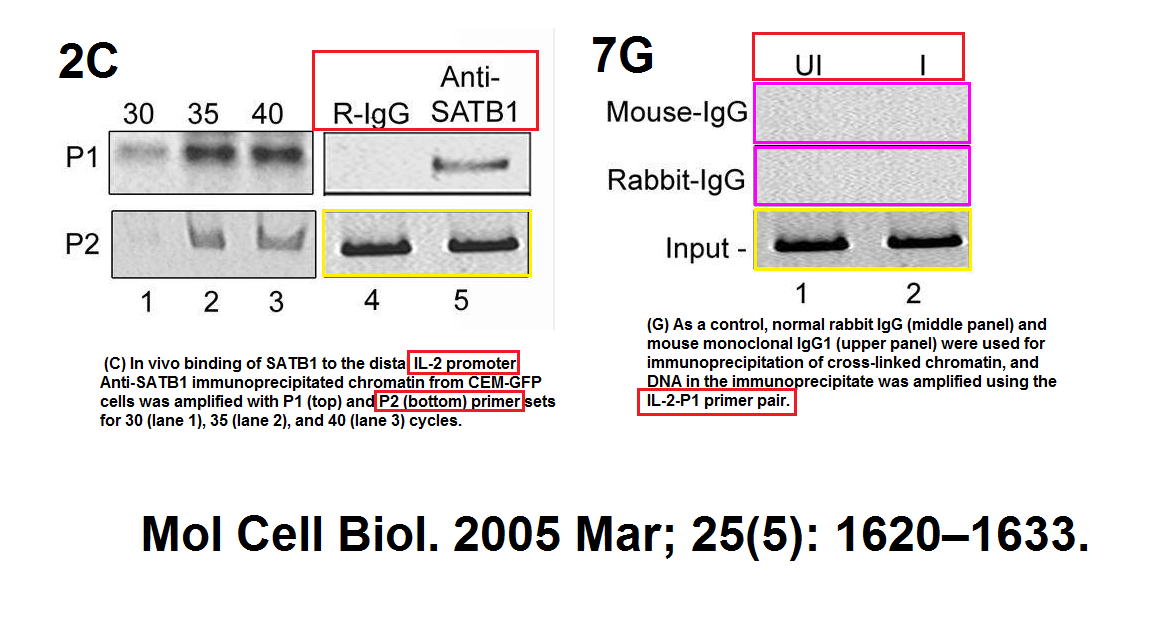
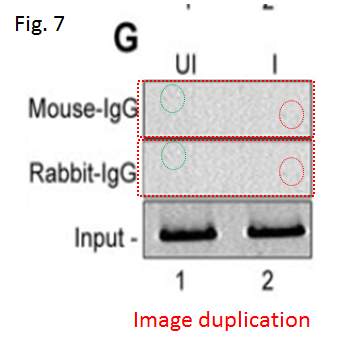
Galande explained on PubPeer:
“This is also an artifact created by the thermal printer and hence the patterns appear similar. This particular thermal printer created shadows and also dots in some kind of a pattern. Once this was realized the printer was not used. The original records reveal that the prints are faded (its has been over 15 years since these were printed) and hence we are not able to reproduce them here.“
He later admitted the duplication, but only in Figure 7, and on 7 March 2022 this bizarre Correction appeared:
“Page 1624, Fig. 2C, lower panel: Lanes 4 and 5, representing the input of the ChIP reaction amplified using the IL-2-P2 primer pair, appear identical to the input control panel (lanes 1 and 2) using the IL-2-P1 primer pair for Fig. 7G. Both are supposed to represent equal amounts of chromatin, equivalent to loading controls.
Page 1628, Fig. 7G: The control panel (Mouse-IgG on top and Rabbit-IgG in the middle) for the ChIP-PCRs is inadvertently duplicated. Because of the time elapsed since publication, the original gel images are no longer available. This duplication does not change the overall conclusions of the article. We apologize for the confusion it might have caused.”
See, if Galande says the gel bands ain’t duplicated, then they ain’t. And if they are, conclusions are not affected.
Concerns for Girnita
Trouble afoot for Karolinska Institutet cheaters, Leonard Girnita and his mentor Olle Larsson?
Croce begat Calin, and Calin begat Girnita…
An academic dynasty of bad cancer research.
This paper now received an Expression of Concern:
Yuntao Xie , Maria Törnkvist , Yan Aalto , Gunnar Nilsson, Leonard Girnita , Bálint Nagy , Sakari Knuutila, Olle Larsson Gene expression profile by blocking the SYT-SSX fusion gene in synovial sarcoma cells. Identification of XRCC4 as a putative SYT-SSX target gene Oncogene (2003) doi: 10.1038/sj.onc.1207153
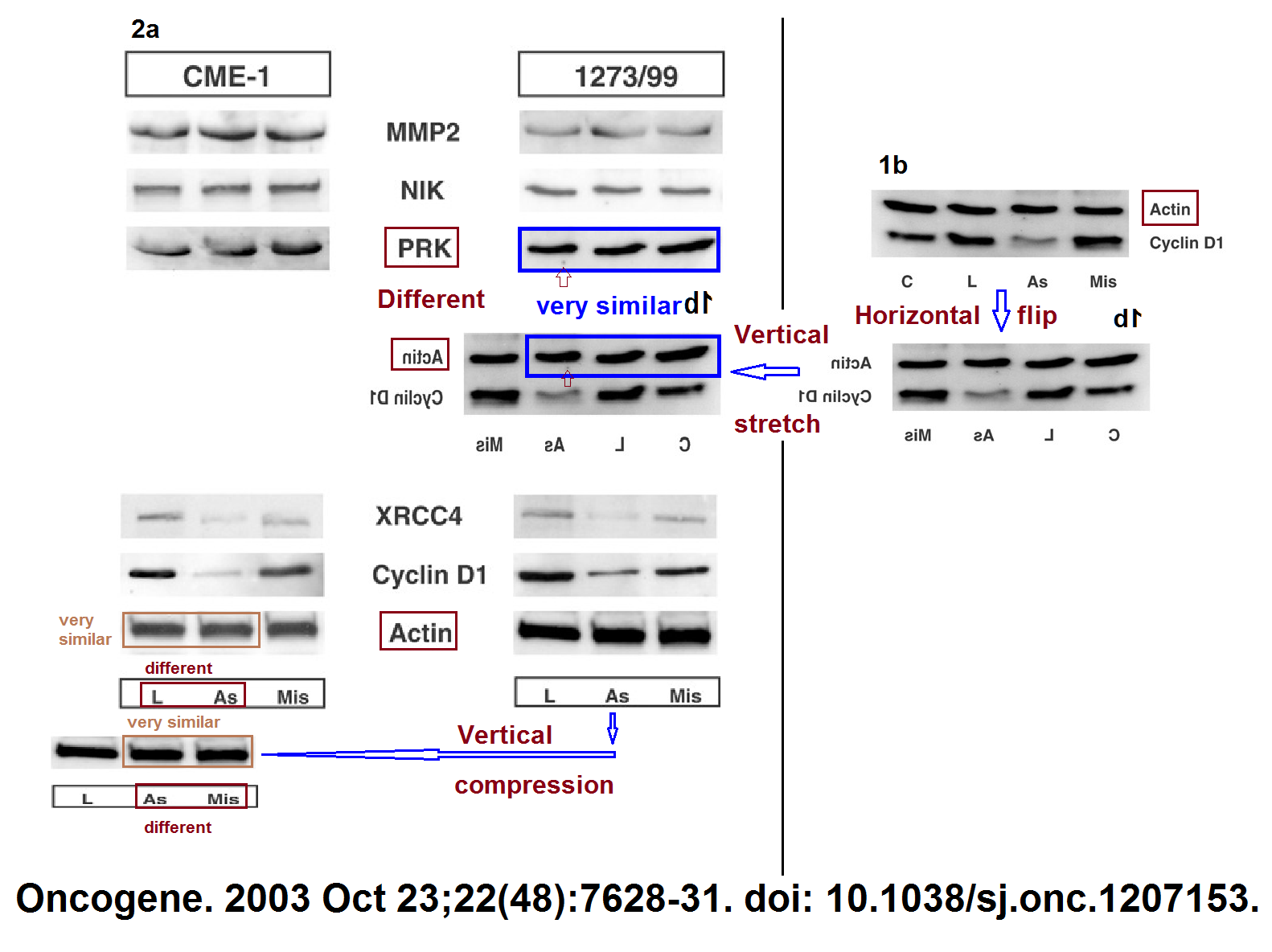
The editorial Expression of Concern appeared on 23 October 2003:
The Editors would like to alert the readers that concerns have been raised regarding the data presented in this article. Specifically:
- Fig. 1b Actin (flipped horizontally) and Fig. 2a PRK bands appear to share a number of background features, as well as similar band shapes;
- Fig. 2a and b appear to have breaks in the western blot backgrounds.
The authors have stated that the images in Figs. 1b and 2a are similar, but not identical, and attributed the background inconsistencies in Fig. 2 to loss of image quality during figure processing.
As the raw data for this article are no longer available due to the age of the study, readers are advised to interpret the presented results with caution.
Maria Dollhopf (formerly Maria Törnkvist), Sakari Knuutila and Olle Larsson agree to this Editorial Expression of Concern. Yuntao Xie, Gunnar Nilsson, and Leonard Girnita have not responded to any correspondence from the editor or publisher about this Editorial Expression of Concern. The Publisher has not been able to obtain a current email address for Yan Aalto and Bálint Nagy.
Strange that Girnita is not responsive. Sulking?
Author confusion
Everything russia does is cack-handed. Even their papermills screw things up, good for them the editors at Elsevier are even more stupid and incompetent.
Look at this paper:
Nurzhan K. Bulatov , Dauren K. Sarzhanov , Sagyntay Z. Elubaev , Tynys B. Suleymenov , Kuralay S. Kasymzhanova , Oyum T. Balabayev Engineering and experimental testing of prototypes of biogas equipment Renewable Energy (2020) doi: 10.1016/j.renene.2020.06.127
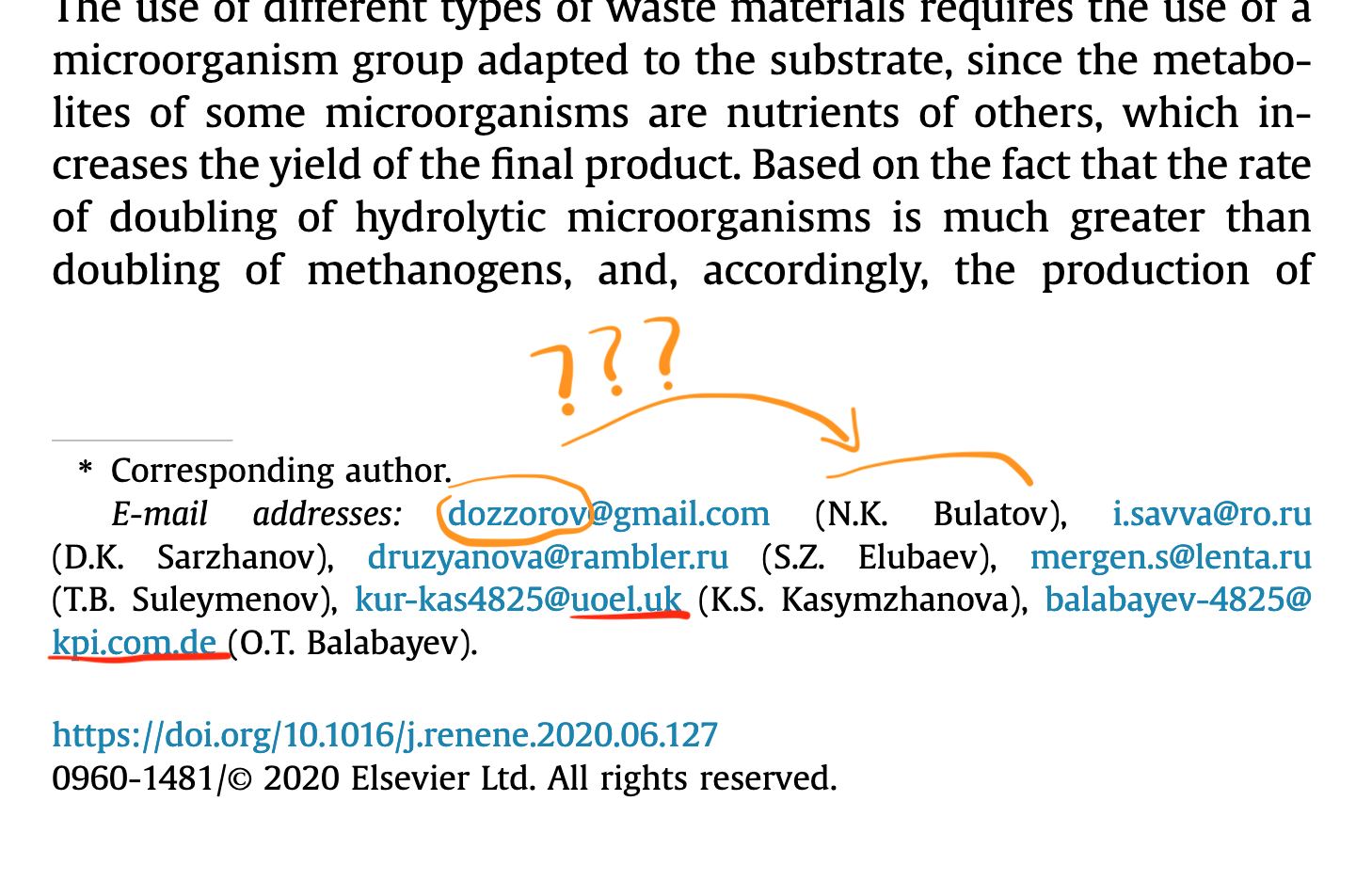
For the first to forth authors, the email addresses seem not to match their names at all.“
Alexander Magazinov swiftly found out why the “authors’ names do not match the names of their provided email addresses. It has to do with this publication in a journal by the Polish Academy of Sciences, where the authors Dozorov (rector of Ulyanovsk State Agricultural University, deceased in 2019), Savvateeva, Druzyanova and Sangadzhiev match the names on the emails above:
Vadim R. Alabiev , Alexander V. Dozorov , Irina A. Savvateeva , Varvara P. Druzyanova , Mergen M. Sangadzhiev Archives of Mining Sciences Committee of Mining PAS (2020) doi: 10.24425/ams.2020.133192


That paper was quite likely a product of the same russian papermill which later on got lazy. One product by this mill was retracted in October 2022, as Anna Abalkina noted:
Alima Auanasova , Erkesh Nurpeisov , Kamilla Auanassova , Ganizhamal Kushenova , Nurlan Mukhlissov The History of the Alash Party in the Context of the Impact on the Processes of Constitutional Acts Ancient Asia (2022) doi: 10.5334/aa.308
The retraction note said:
“The paper (Auanasova et al. 2021) is considerably different to the manuscript that went through peer review and is authored by a different team of authors. These significant changes took place without the journal’s and the previous authors’ approval. Therefore, the published paper has not undergone peer review. This is against journal policy and thus the paper is being retracted.”
Maybe after Dozorov died in April 2019, he was unavailable to buy the new product submitted in February 2020. So the mill had to find new buyers and couldn’t be arsed to change the fake emails. Elsevier and the editors of the journal Renewable Energy (Impact Factor 8.6) did not mind.
Science Breakthroughs
Musical genes
The Max Planck Institute for Empirical Aesthetics in Frankfurt, Germany, announced a groundbreaking discovery. Here the institutional press release from 7 November 2022:
“A total of 5,648 study participants provided their DNA, filled out questionnaires related to music, and completed music-oriented tasks. Among other things, they were evaluated for how well they could discriminate rhythm, melody, and pitch. On the basis of their DNA, the scientists calculated each participant’s polygenic score, or PGS, for beat synchronization ability, i.e., rhythm. This score thus served as an indicator of the genetic basis for a person’s sense of rhythm.
First author Laura Wesseldijk of the MPIEA gives a more detailed account: “We discovered that the PGSrhythm could predict participants’ overall musicality because genetic variants that inform beat synchronization ability are related to other aspects of musicality. These include not only people’s abilities to follow a melody or distinguish rhythm or pitch, but also the amount of time they spend practicing or listening to music in general.”
The study was actually done at Karolinska Institutet in Sweden, but the lead author Laura Wesseldijk is in Frankfurt now, hence the German press release whcih made the news nation-wide. Karolonska wisely stayed silent, maybe they understood that it’s one of those silly twin studies eugenicists love, aiming to prove that the social status of rich people and their children is genetically vouchsafed by superior quality genes. More from the Frankfurt press release:
“A person’s environmental exposure (e.g., whether or not they receive music lessons) also depends in part on their genetic predisposition for music.
The study’s findings show that PGSrhythm can predict not only a person’s overall musicality, but also—along with the ability to dance—their tendency to enjoy music and engage with it. The polygenic score can thus reliably be used in future research to study the genetics underlying individual differences in music skills and to disentangle gene–environment interplay.”
At least they don’t propose for music schools to establish genetic tests as entrance exams. The study ended up in Scientific Reports, probably having rolled down all the way from Nature and the fancy Karolinska Institutet credentials didn’t help:
Wesseldijk, L. W., Abdellaoui, A., Gordon, R. L., 23andMe Research Team, Ullén, F., & Mosing, M. A. (2022). Using a Polygenic Score in a Family Design to Understand Genetic Influences on Musicality. Scientific Reports, (2022) DOI: 10.1038/s41598-022-18703-w
None of the authors declares a conflict of interests, even though the authors list includes “23andMe Research Team”, a genetic test company which most certainly wants you to buy their musicality screening services.
And one of the authors, the University of Amsterdam professor Abdel Abdellaoui, is an open-faced eugenicist. He previously announced in Nature Genetics (Abdellaoui et al 2019) that
“people who have more genetic variants linked to higher levels of education are on average more likely to live in wealthier areas of Great Britain, whereas people who have fewer of these variants are on average more likely to live in regions that have faced economic challenges, such as coal mining regions.”
I asked the Max Planck Institute in Frankfurt if they have a problem with eugenics. Nobody replied. Guess they don’t talk to people with low quality genes.
I am not a racist but…
Some geneticists have very unorthodox ideas. These might sound like racism or eugenics to simple folks, but it is really high science. UK Biobank is apparently on board.
News in Tweets
- Second chances, right? The Chinese geneticist Jiankui He, who in 2018 illegally experimented on humans to created gene modified babies (or faked these results?) is out of prison, set up a new lab and is recruiting!
CRISPRed babies in China: a growing scandal
First gene-edited human babies were allegedly born, two twin girls. Jiankui He, associate professor at the South University of Science and Technology of China claimed to have used CRISPR gene editing technology, in a registered clinical trial, to make babies resistant to HIV. Did this really happen? In any case, everyone now takes distance to…
- France and its CNRS once again mercilessly crack down on research fraud. The Starsbourg plant scientist Thalia Salinas, whose PhD thesis and papers (supervised by IBMP director Laurence Drouard) were long exposed for fake data, is now duly punished in the classic French way. Hard, but fair, all for the glory of French science. Salinas, who is married to IBMP group leader and University fo Strasbourg professor Philippe Giege, has been now subjected to a “habilitation” ceremony to qualify as professor, served champaign and a bouquet of flowers, and was sentenced to the tenured and handsomely paid position of Research Director at IBMP. She will now set up her own Photoshop lab and train the next generation of little science fraudsters. Vive la France!
The Strasbourg Swamp
You know Voinnet, but now meet other great life scientists of Strasbourg: Drouard, Loeffler, Boutillier, Mr and Mrs Egly, and many others.
- Oxford University Press is always ready to help fellow white Anglosaxon cheaters, this time from Canada. Journal reply to Cheshire about Medina et al 2016: “We have had a member of the Journal’s board with expertise in the area and no conflicts of interest with any of the authors review your concern. The expert reviewer found that although there is visual similarity, it is not meaningful and would not affect the conclusions of the paper. We do not intend to pursue further investigation. We have passed your Pubpeer posting on to the author in case they would like to respond on Pubpeer. We thank you for your dedication to preserving the scientific record and appreciate you bringing this concern to us. Sincerely, Editorial Office, The Journal of Burn Care & Research“.
- The authors (or papermillers) of Gong & Liu 2022 needed to add error bars. They just typed capital Ts. Seriously, look closely. It passed peer review at Hindawi! Also: “Data Availability: Data sharing is not applicable to this article as no datasets were generated or analyzed during the current study.“
- New at Hindawi: Fake Science Bingo! (Kaya-Ongoto et al 2019)
- Also in Hindawi – amazing peer-reviewed Receiver Operating Characteristic (ROC) curves! (Zheng et al 2022) More of the same papermill ROC artwork in Frontiers (Zhou et al 2021) and in BioMedCentral by Springer Nature (Li et al 2020).
- For MDPI, a paying customer is always king. Obviously MDPI wants Shaker Mousa to “sever”.
Shaker Mousa – NY pharma gangsta’
Yo, what’s up, my homies, Shaker Mousa is in da house.
- Nick Brown’s thread about the recent retraction for Nicolas Guéguen:
- Over the course of pandemic, Anthony Fauci slowly progressed from “COVID-19 lab leak is a conspiracy theory” via “lab leak origins can’t be excluded” to “well, it was quite likely a lab leak, but USA was definetely not involved”.
Viral by Alina Chan & Matt Ridley – Book review
Alina Chan’s book with Matt Ridley on the Origins of COVID-19 is finally out. It is a very informative read!
- Biogen’s second Alzheimer’s drug seems to be working even better than their first already FDA-approved drug Aduhelm, which didn’t cure but also didn’t kill people: “A 65-year-old woman who was receiving a promising experimental treatment to slow the cognitive decline caused by her early Alzheimer’s disease recently died from a massive brain hemorrhage that some researchers link to the drug. The clinical trial death, described in an unpublished case report Science has obtained, is the second thought to be associated with the antibody called lecanemab.” (Science)
- Matt Williams commented on the fraudulent DCVax clinical trial for glioblastoma by Northwest Biotherapeutics which recently appeared in JAMA: “Our main concern with the methodology is the change in comparison arm. […] The published study compared treated cohort with external controls. In fact out of 1599 patients screened, 1268 were excluded for a range of reasons including disease progression and early clinical deterioration (Liau JTM 2018).“
- Don’t forget to watch online the workshop in Liverpool, on 5 December 2022!
I thank all my donors for supporting my journalism. You can be one of them!
Make a one-time donation:
I thank all my donors for supporting my journalism. You can be one of them!
Make a monthly donation:
Choose an amount
Or enter a custom amount
Your contribution is appreciated.
Your contribution is appreciated.
DonateDonate monthly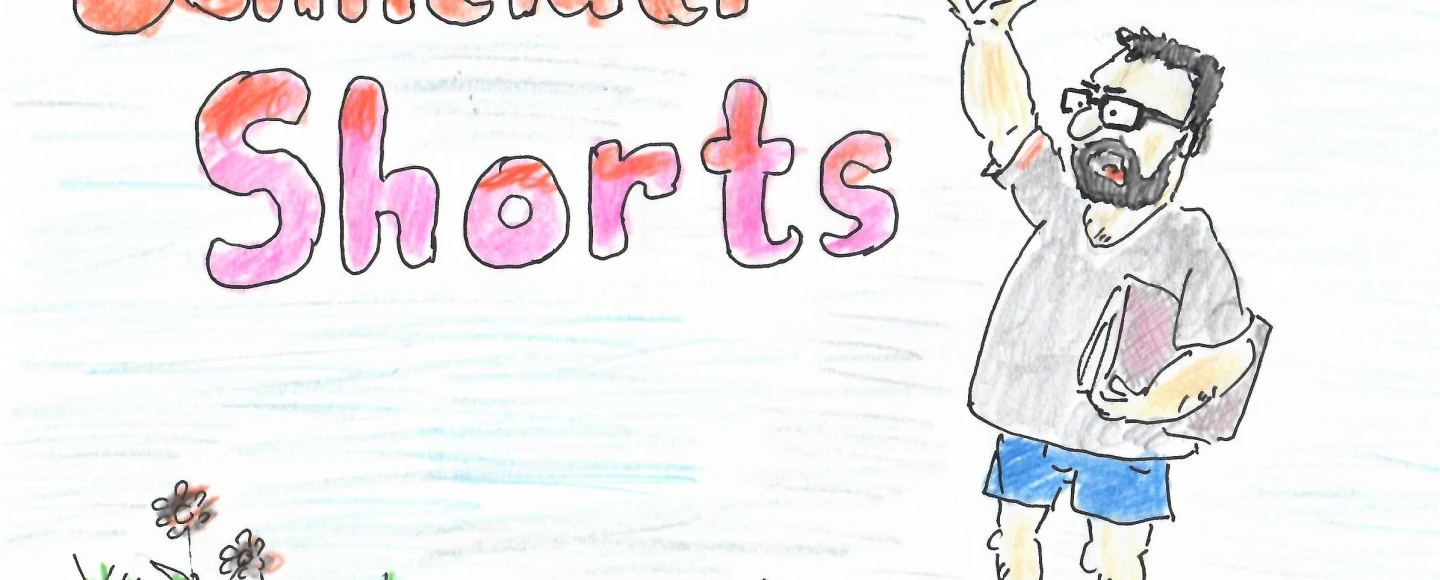

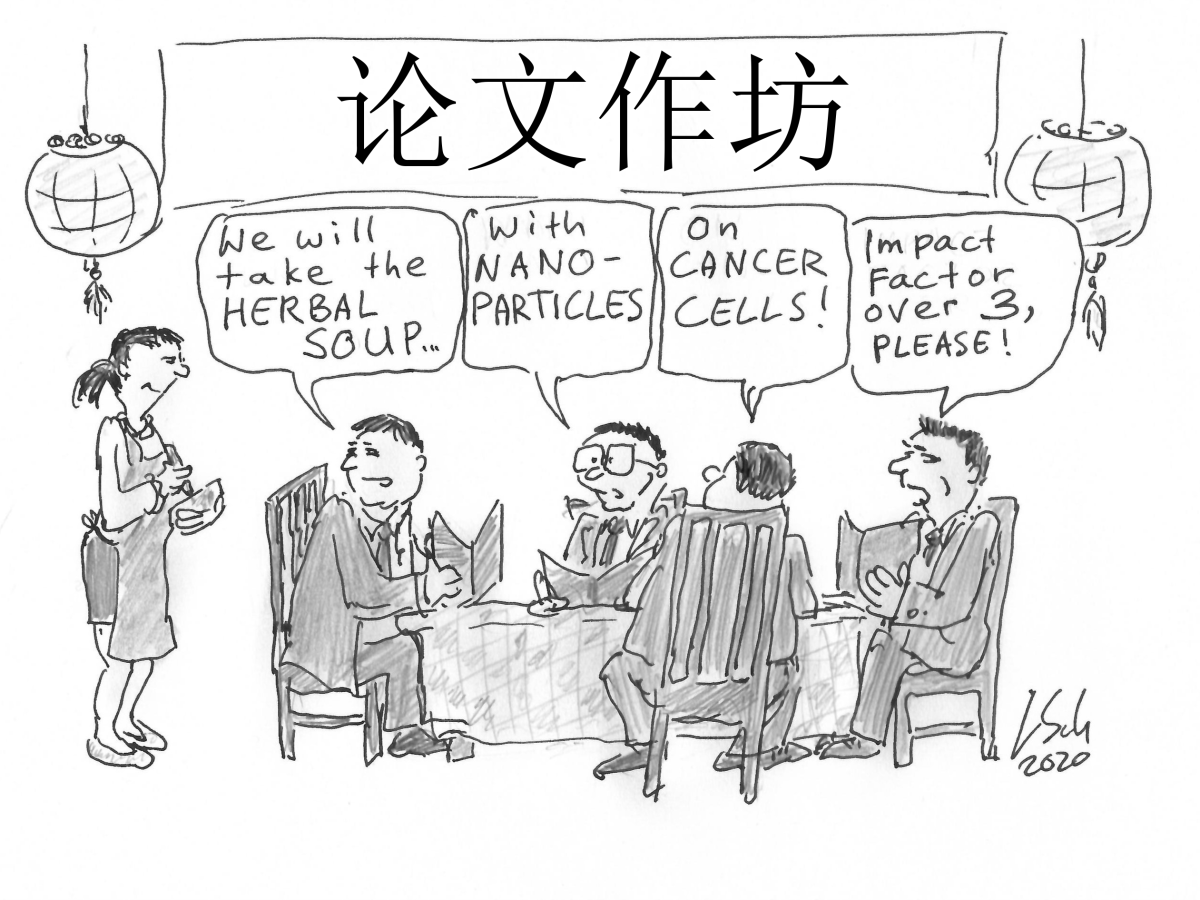
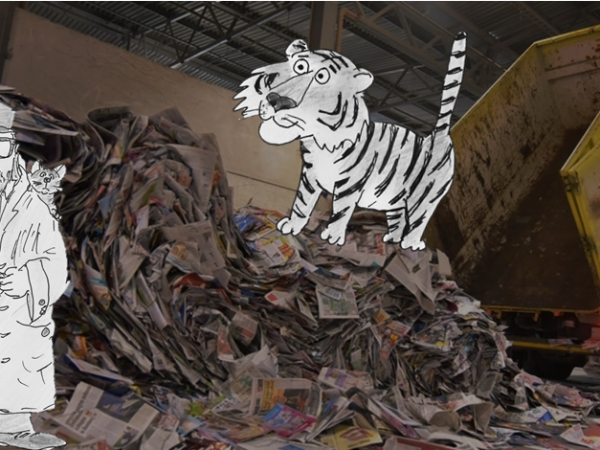

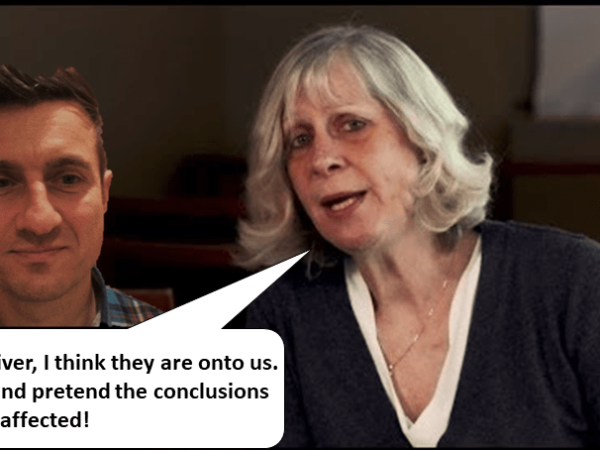



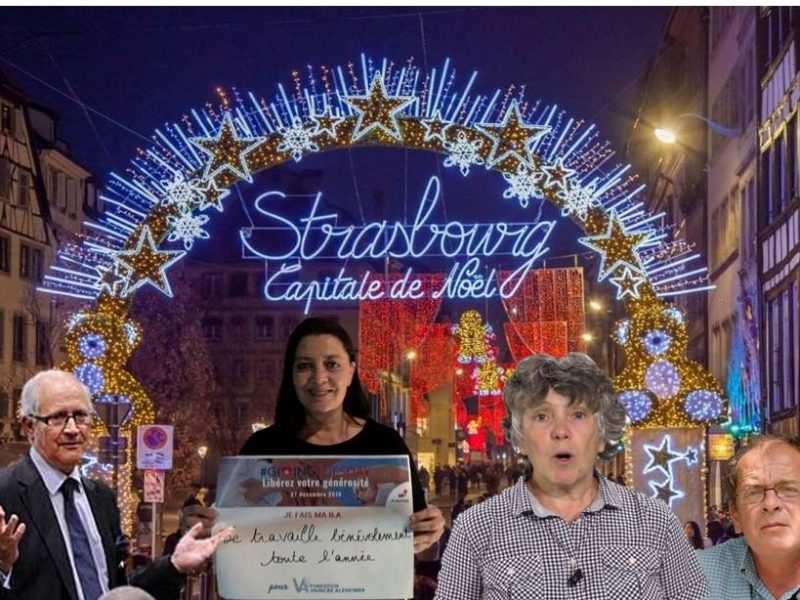



Moar!
LikeLike
Elke Stein is coauthor!
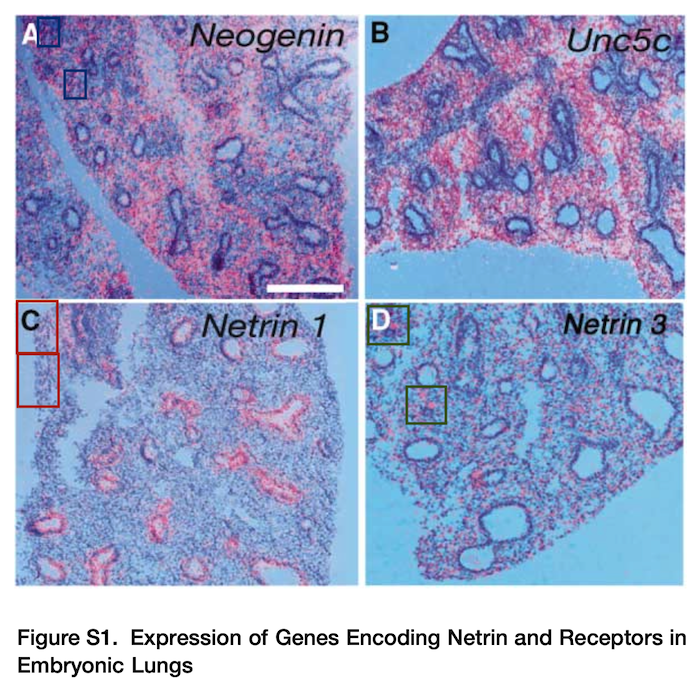

Yuru Liu , Elke Stein , Timothy Oliver , Yong Li , William J Brunken , Manuel Koch , Marc Tessier-Lavigne, Brigid L.M Hogan
Novel Role for Netrins in Regulating Epithelial Behavior during Lung Branching Morphogenesis Current Biology (2004) doi: 10.1016/j.cub.2004.05.020
etc…
LikeLike
hi Leonid, https://www.tandfonline.com/doi/abs/10.1080/00224545.2011.605398 does not indicate that this paper is retracted.
The DOI of the retraction note, https://doi.org/10.1080/00224545.2022.2151704 , does not (yet) exist (“DOI Not Found”).
LikeLike
“As Alexander Magazinov criticised on PubPeer, if the retraction notice does not mention papermills and the omniscient Retraction Watch experts won’t log those retractions as due to papermilling, then it won’t enter the analysis of our esteemed experts from Spain.”
To my mind, the role of Retraction Watch is that of “Coroners of Bad Science”. Papers are found in shallow graves; at RW they keep track of the gravesites, and see if there are broader lessons to be learned from the internments. I hope this isn’t too great a distortion of Ivan’s and Adam’s intentions.
It’s a noble goal, but anyone researching questions like “Why are all these papers turning up in shallow graves after unfortunate woodchipper-related accidents?” should probably invite the perspective of those of us who are wandering around the scene carrying shovels and looking furtive.
LikeLike
How wrong you are. As Retraction Watch’s Ivan Oransky and Adam Marcus, as well as Lex Bouter, Holden Thorp , Jeffrey Flier, Dror Koldkin-Gal and other grand men of research integrity said time and time again: who the fuck are you all, you ignorant, creepy, anonymous and penniless losers?
LikeLike
“faeces have hit the ventilator” I always liked Vonnegut’s “the excrement has hit the air conditioning”
LikeLike
As a handy software says, “The cooling system has indeed been impacted by manure.”
LikeLike
https://pubpeer.com/publications/963046659F06B2FD62119770412612#4
Here, Brigid L.M Hogan wants to tell us that,
“I agree that the highlighted areas do appear to have some similarities. However, this must be by chance, reflecting in part the repetitive nature of the process of branching morphogenesis and the structure of the embryonic lung.”
LikeLike
“The origin of the tiling and of the partial overlaps is unknown but may have occurred during transfer of images to the journal.” If that’s the best excuse they can think of, no wonder they can’t do real science. Might as well invoke mischievous elves. This person is not qualified to be the dogcatcher in Cattown, let alone a university president.
LikeLike
“dogcatcher in Cattown”
Can anybody apply for that job?
LikeLike
So nice to see that my friends from Central Michigan are mentioned in the same page as the president of Stanford! Way to go CMU! Fire up Chips!!
LikeLike
Recall that an anagram of Stanford is: snodfart. Seems fitting in this context.
LikeLike
LikeLiked by 1 person
Stanford Uni-fucking-versity is not going to dethrone its King in a million years. Nothing to do with the Enlightenment, but all to do with bags and bags of money. That goes for most universities. Why should we be polite about it. We may be on the verge of another 1789, yet the universities have not learned that in most, if not all Western democracies, even the U.S.A., the voters have turned against unbridled capitalism.
LikeLike